Bay Burger
Bay Haze
Black Russian
Blue Ace Auto CBD
CBD Jam
Caramelo
Caramelo Fast Version
Cheese Candy Auto
Chocoband
Cotton Candy
Cotton Candy Kush Early Version
Critical Jack Herer
Critical Jack Herer Auto
Critical Kali Mist
Critical Neville Haze
Critical Neville Haze 2.0
Critical Neville Haze Auto
Critical Neville Haze Early Version
Critical Sensi Star
Critical Sensi Star Early Version
Critical Super Silver Haze
Critical Yumbolt
Dark Lemonade Auto
Dark Purple Auto
Deep Mandarin
Delicious Candy
Delicious Candy Fast Version
Delicious Cookies
Delicious Cookies Auto
Delimed CBD Plus
Descojack
Desconocida Kush
Eleven Roses
Eleven Roses Automatic
Eleven Roses Early Version
Fruity Chronic Juice
Golosa
Golosa Early Version
Honeybells
Il Diavolo
Jota Mayúscula Purple Auto
Jägg Kush
La Bella Afrodita
La Diva
La Frutta di Venus
La Musa
Lord Kush
Marmalate
Marmalate Fast Version
Moby Delicious
Neville’s Rose Auto
Northern Light Blue
Northern Light Blue Auto
Northern Light Blue THC Free
Northern Lights X Big Bud Early Harvest
Original Juan Herrer
Purple Mango Kush
Space Cookies Auto
Sugar Black Rose
Sugar Black Rose Auto
Sugar Black Rose Fast Version
Sugar Candy
Sunday Punch
Sunday Punch Early Version
Unknown Kush Early Version
Growreps Storie Merchhandising Stickers Catalogs
Delicious Seeds, a Spanish cannabis seed bank based in Valencia, stands out for its dedication to crafting high-quality, flavorful strains with unique aromas and effects. Founded by Ruben Fernandez in March 2009, the company specializes in feminized, autoflowering, regular, and CBD-rich varieties, catering to both recreational and medicinal users. Marketed as collectible souvenirs to comply with international cannabis laws, it maintains a boutique approach despite limited public financial details.
Ruben Fernandez: The Visionary Behind Delicious Seeds
Ruben Fernandez, the founder and CEO, brings over 26 years of cannabis expertise to the table, a passion ignited during the late 1990s and early 2000s amid Spain’s evolving cannabis culture. Now around 50 years old, he keeps a low personal profile, with no public details on family life. His hands-on cultivation experience drives his mission to create strains with exceptional flavors and potency, reflected in the brand’s name. Fernandez co-founded the company in 2008-2009 with partners like Roberto, starting with informal genetics experiments in Torrent, Valencia. His vision—blending global genetics for indoor and outdoor grows—led to the debut of commercial strains at Spannabis 2009. As CEO, he oversees a tight-knit operation prioritizing innovation over mass production, growing the catalog to over 64 strains by 2025 with a presence across four continents.
A self-described «fan of the Old School of Amsterdam,» Fernandez’s early influences shape strains like Original Juan Herer and Jagg Kush. He shuns aggressive marketing, focusing on community engagement and product integrity, as seen in his podcast discussions on Spanish regulations, indoor growing benefits, and Barcelona social clubs. His private life remains undisclosed, with professional endeavors taking center stage.
History and Growth
The company’s roots trace back to Fernandez’s experimental breeding, launching with a focus on high-THC, THCV, and CBD ratios. Early success at cannabis cups by 2010 cemented its reputation, and annual releases—four new strains in 2022 alone—keep it fresh. Operating under legal disclaimers, Delicious Seeds ships globally (except where prohibited, like the U.S.) through distributors and online platforms, balancing compliance with expansion.
Trips and Travels
Fernandez’s travels revolve around the cannabis industry, representing Delicious Seeds at key events. He regularly attends Spannabis in Barcelona (e.g., 2024-2025 at booth 102 with giveaways) and Spannabis Bilbao (e.g., September 2024 at booth 103), engaging in networking, competitions, and fan interactions. Internationally, his presence is linked to award wins, such as Golosa at the 2022 Rosario Cannabis Cup in Argentina, Marmalate at the 2022 Poco Humo Cup, and Sugar Black Rose at the 2020 Castellon Cannabis Cup. Other victories include the Autoflower World Cup 2024 in Barcelona (Delicious Cookies Auto) and the 2019 Product Earth podcast in the UK. These trips span Europe and potentially South America, focusing on building global partnerships.
Achievements
Fernandez has transformed Delicious Seeds into a globally recognized brand, earning over 220 awards since its start (up from 40+ earlier). Highlights include Sugar Black Rose as Best Indica at Spannabis 2014, Caramelo’s multiple cup wins, and Eleven Roses’ High Times honors. Recent successes like Golosa (2022) and Sugar Black Rose (2020) showcase his leadership. He’s grown the brand from a local Valencia outfit to an international player with over 22 countries served, pioneering early autoflowering strains and maintaining a niche focus on quality. As a mentor to growers and breeders, his podcast expertise on legal and cultivation topics solidifies his status as a self-made innovator.
Popular Strains
The catalog features over 64 strains, blending indica, sativa, and hybrid genetics with terpene-rich flavors (fruity, sweet, earthy).
Standouts include:
Eleven Roses (Sugar Black Rose x Appalachian Kush), аn indica-dominant hybrid with sweet berry flavors, deep relaxation, and 25% THC, ideal for beginners.
Sugar Black Rose (Black Domina x Critical Mass) classic with sugary aroma, narcotic effects, and 18-25% THC, a medicinal favorite.
Cotton Candy Kush (Lavender x Power Plant) hybrid with cotton candy taste and 20-25% THC, known for high yields.
Golosa (Bay 11 x Grapefruit x Blueberry) a bestseller with berry notes and 20-26% THC, including autoflowering options.
Chocobang (Chocolope x OG Chocolate Thai) a sativa-dominant with chocolate-coffee flavors and up to 26% THC, great for creativity. Critical Neville Haze (Critical Mass x Neville Haze) a sativa-heavy strain with spicy, hazy effects and resilience.
Other notable strains include Caramelo (caramel flavors), Black Russian (medicinal indica), and CBD Jam (high-CBD). Newer releases like Bay Burger (citrusy) and Lord Kush (relaxing) are gaining traction in 2025, with categorized packs like «Best Sellers Collection» boosting popularity.
Workforce and Finances
As a private company, exact employee numbers are undisclosed, but estimates suggest fewer than 20 staff, handling breeding, quality control, and support under Fernandez’s leadership. Financials are private, but the global seed market’s $1-2 billion valuation (2025) and comparisons to similar Spanish banks suggest revenues of €1-5 million annually, driven by online sales and promotions (e.g., 65 free seeds on €900+ orders). Self-funded with no investors, it thrives on e-commerce volume.
Additional Details
Based in Valencia, with a customer service line and shipping discreetly worldwide. Includes grow guides, personalized advice, and bundles, with strains for all levels and THC-free options like Northern Light Blue. Over 100 awards, featured in 420 Magazine and SeedFinder. Sold via Herbies, Oaseeds, and Toro Growshop, with active social media (e.g., 2025 X posts) and breeder collaborations. Emphasizes equality, efficiency, and transparency, offering free support and legal compliance.
Delicious Seeds, under Fernandez’s guidance, remains a flavor-focused leader, building a loyal following despite limited transparency, with potential for further growth as the industry evolves.
Advanced Hydroponics of Holland is a Dutch company that produces liquid fertilizers and nutritional supplements for plant cultivation. The company is known for its original Dutch Formula, a three-part nutrient system that has been used by growers since 1996. Its products are suitable for all types of growing media, including hydroponics, coco coir, and soil.
Main man
It was founded in 1993 by Jay Jackson, an experienced grower who aimed to create an alternative to traditional fertilizers unsuitable for the specific needs of cannabis and other crops. Jackson collaborated with the Plant Nutrition Research Center in Aalsmeer, Netherlands, where biochemists developed a formula that, after testing, showed excellent results. The company started with retail sales but quickly shifted to wholesale distribution due to demand at trade shows, such as one in Germany in 1996.
Jay Jackson is the founder and executive director of the Dutch company Advanced Hydroponics of Holland (AHoH). Information about his personal biography is quite limited, as Jackson leads a relatively private life, and public data mostly pertains to his professional activities. There are no details about his education or early years—he is primarily known as an experienced grower with deep knowledge in plant nutrition. His business approach is rooted in personal cultivation experience, emphasizing simplicity, efficiency, and affordability of products.
Biography
Jackson is a passionate grower with decades of experience, beginning his career in the late 1980s to early 1990s. At that time, like many other cultivators, he faced challenges with traditional fertilizers designed for common plants. These products required complex combinations, did not guarantee stable yields, and failed to account for cannabis’s unique nutrient needs. This motivated Jackson to seek an alternative. He collaborated with the Plant Nutrition Research Center in Aalsmeer, Netherlands, where biochemists developed a new formula. Jackson personally tested it alongside other growers, and the results exceeded expectations—yields became more stable and of higher quality.
Little personal information is available about Jackson: he is American by origin, but the company is based in the Netherlands, in Best, North Brabant. In interviews and articles, he emphasizes that his product vision stems from his own experience as a grower, not from marketing gimmicks. Jackson is known in the industry as a «father» or mentor to many, including renowned breeders like Scott Blakey (Shantibaba) from Mr. Nice Seeds, who has used AHoH products since the 1990s. He actively participated in industry trade shows, such as Cannafest in Prague, Cultiva in Austria, and Cannatrade in Switzerland, where he represented the company and engaged with the community.
In recent years, Jackson has stepped back from operational management and now splits his time living between Portugal, America, and the Netherlands, though his contribution to the company remains pivotal.
Commerce
Jackson’s commercial path began with a personal challenge as a grower and led to the creation of a successful business:
1993: Founding the Company. After successful tests of the new formula, Jackson founded AHoH to sell fertilizers at retail. The goal was to offer a product combining ease of use, high efficiency, and competitive pricing. The flagship product—Dutch Formula (Grow, Bloom, Micro)—allows flexible nutrient adjustment across growth stages.
1996: Breakthrough. At a major trade show in Germany, demand for the products exceeded expectations, shifting the business from retail to wholesale distribution. This marked the beginning of global expansion: today, AHoH operates through over 60 distributors in more than 22 countries (Europe, Russia, Japan, the UK, and others).
Expansion of the Product Line. In the 2000s, an organic series called Natural Power (Root Stimulator, Enzymes, Excellerator, Final) was added, focusing on natural additives. Jackson stresses that the company’s success lies in its focus on proven recipes, avoiding «magic boosters» or promises of doubling yields. Instead, the products help plants reach their maximum potential.
Modern Stage. The company has weathered competition (many rivals have closed), investing in new warehouses and its headquarters. Jackson envisions the future in stable quality and grower support. AHoH remains small (2–10 employees) but stable, prioritizing quality over aggressive marketing. No public data on revenue exists, but its global presence suggests a successful business in the growing hydroponics market (estimated globally at $5–12 billion).
Jackson is an example of a self-made entrepreneur in a niche industry, where his grower experience became the foundation of his success.
Where It Sells
Based in the Netherlands (previously in Uithoorn, now in Best, North Brabant), the company operates through a network of over 60 distributors in more than 22 countries. Key regions include Europe, as well as Russia, Japan, the UK, and others. Products are available in specialized grow shops, online stores (e.g., Growmart.EU, Bushplanet, Hyjo, Eden Horticulture), and platforms like eBay. Direct sales to the USA are avoided due to regulations, but distribution occurs globally through partners. Recently, the company invested in new warehouses to support growth.
AHoH is a small private company (2–10 employees), so public financial reports are unavailable. There are no precise figures for revenue or turnover, but its long-standing presence on the market (over 31 years), global distribution, and investments in expansion suggest a stable business.The company focuses on quality rather than aggressive marketing and has survived in a competitive environment where many competitors have closed.
Dutch Formula
The Dutch Formula is the company’s core product line, providing complete plant nutrition for every stage of growth. The three-part system includes:
Natural Power
This line is a range of 100% natural and organic additives and supplements designed to improve plant health and yield. Products include:
- Natural Power Root Stimulator: Helps young plants develop a strong root system.
- Natural Power Growth/Bloom Excellarator: Designed to boost overall growth and flowering.
- Natural Power Enzymes+: An enzyme mixture that helps to activate beneficial microorganisms, break down dead root material, and increase plant vitality.
- Natural Power Final Solution: Used at the end of the flowering cycle, this powerful bloom booster helps drive the plant to maturity.
Other products
In addition to its main product lines, Advanced Hydroponics of Holland offers several other products to help optimize your garden:
- Advanced Amino: A biostimulant with absorbable amino acids that boost energy, vitality, and resilience in plants.
- Advanced PK: A high-quality fertilizer with a balanced phosphorus and potassium ratio, ideal for the flowering and fruiting stages.
- Advanced Calmag: A supplement for calcium and magnesium.
- Advanced Silica: A silica supplement to strengthen cell walls and increase resistance to pests and diseases.
- Starters Kit: A box with all the necessary nutrients for optimal growth and flowering for 2 to 3 plants, containing Dutch Formula Grow, Bloom, Micro, and the Natural Power line.
Green House Seeds, vibrant merch for cannabis culture enthusiasts, is renowned for funny and bright designed stickers that let fans showcase their love for the brand. These stickers are perfect for decorating almost everything: laptops, water bottles, bikes, suitcases, grow rooms. They blend minimalist design with iconic cannabis motifs like leaves, strain logos, and slogans such as «Strain Hunters.»
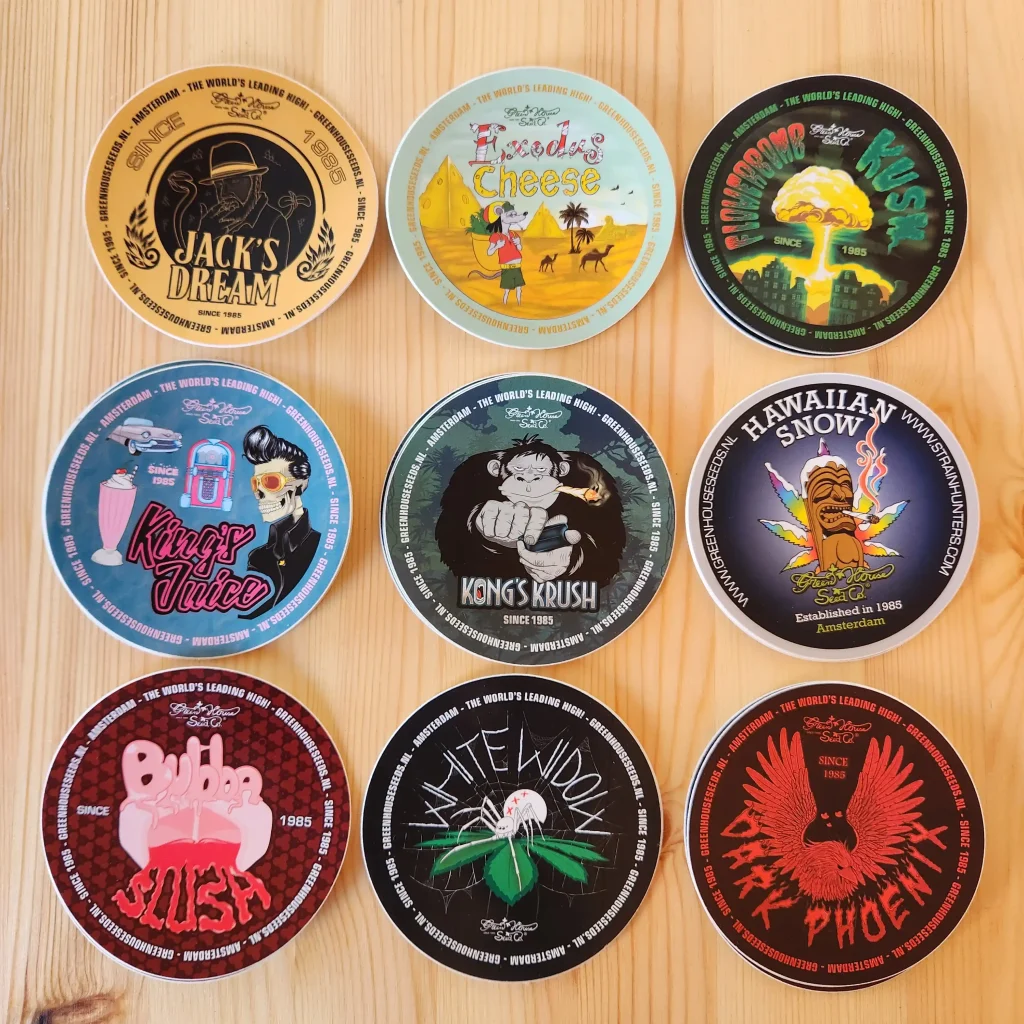
Designs and Variety
The official Green House Seeds online store features a «Merchandise > Stickers» section with sticker packs. While the section may occasionally be out of stock as of October 2025 likely due to updates, typical offerings include:
— Brand Logos: the classic green house emblem with cannabis leaves or bold white «Green House Seed Co.» text on a black background.
— Strains and Characters: stickers featuring popular strains like White Widow, Super Lemon Haze, or Arjan’s Haze, often styled after the Strain Hunters project (Roskam’s quest for rare genetics).
— Collector Packs: sets of 5–10 waterproof vinyl stickers, ranging from 5×5 cm to 10×10 cm. Prices typically range from €5–15 per pack, depending on size.
Stickers are often bundled with other accessories like grinders, lighters, or rolling papers. Fans praise their durability—fade-resistant and long-lasting, they’re ideal for cannabis culture decor.
Where to Buy and Popularity
— Official Store: The primary source is the Green House Seeds website, with worldwide shipping ).
— Partners: Retailers like Seedsman, House of Seeds, or Tiger One sell Green House merch alongside seeds.
— Alternatives: Platforms like Redbubble or Etsy offer fan-made designs, from custom «Greenhouse Academy» stickers to botanical cannabis art. On social media (Reddit, X), enthusiasts share photos of stickers adorning hydroponic setups or personal collections.
The Green House Seeds community values the merch for its authenticity, representing a brand that champions legalization and innovation in cannabis cultivation. Collectors should watch for limited-edition releases, such as collabs like Patta x GH. Affordable and iconic, these stickers are a must-have for growers and fans.
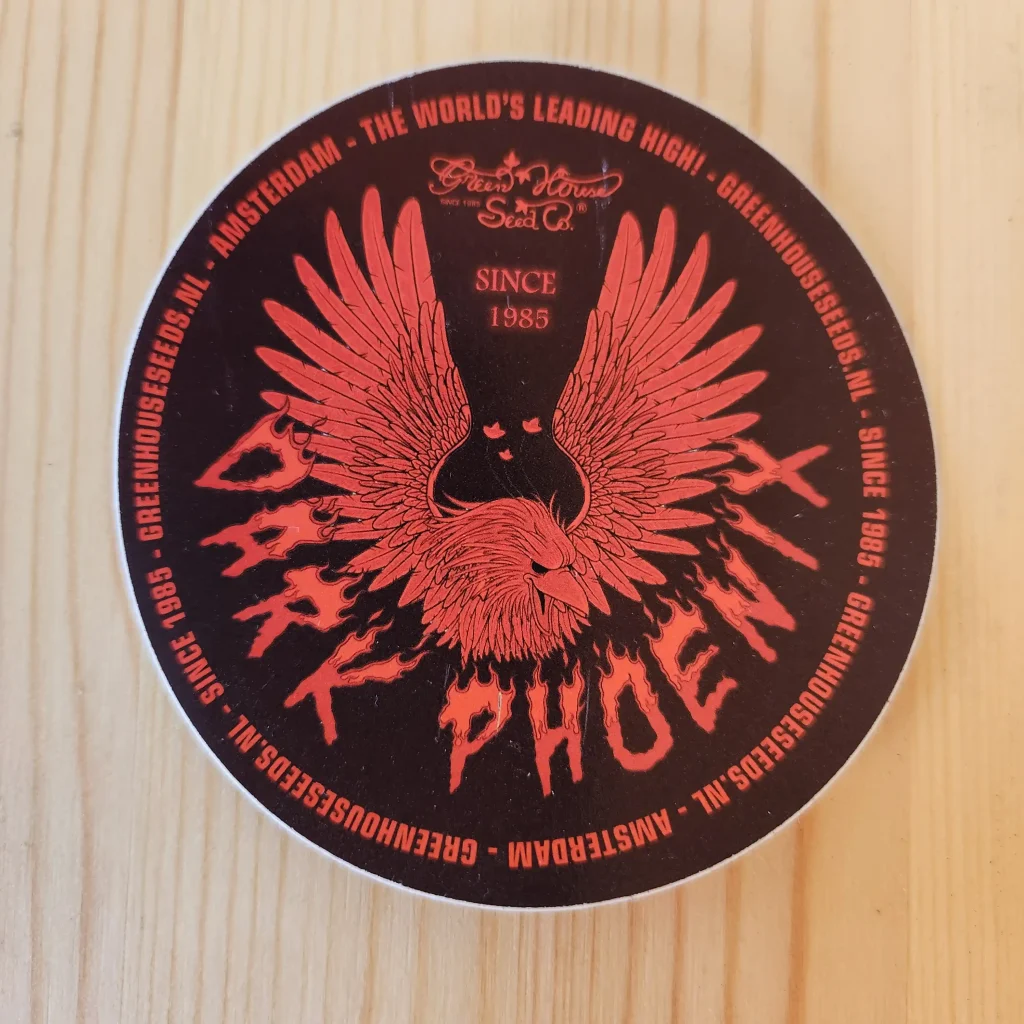
Dark Phoenix
Design: A striking red phoenix with outstretched wings dominates the center, surrounded by fiery accents on a dark burgundy background. The Green House Seed Co. logo and «Since 1985» text reinforce the brand identity.
Theme: Represents rebirth and strength, possibly hinting at a potent strain or its impact.
Aesthetic: Vibrant red and orange hues create a bold, memorable look, appealing to adventurous collectors.
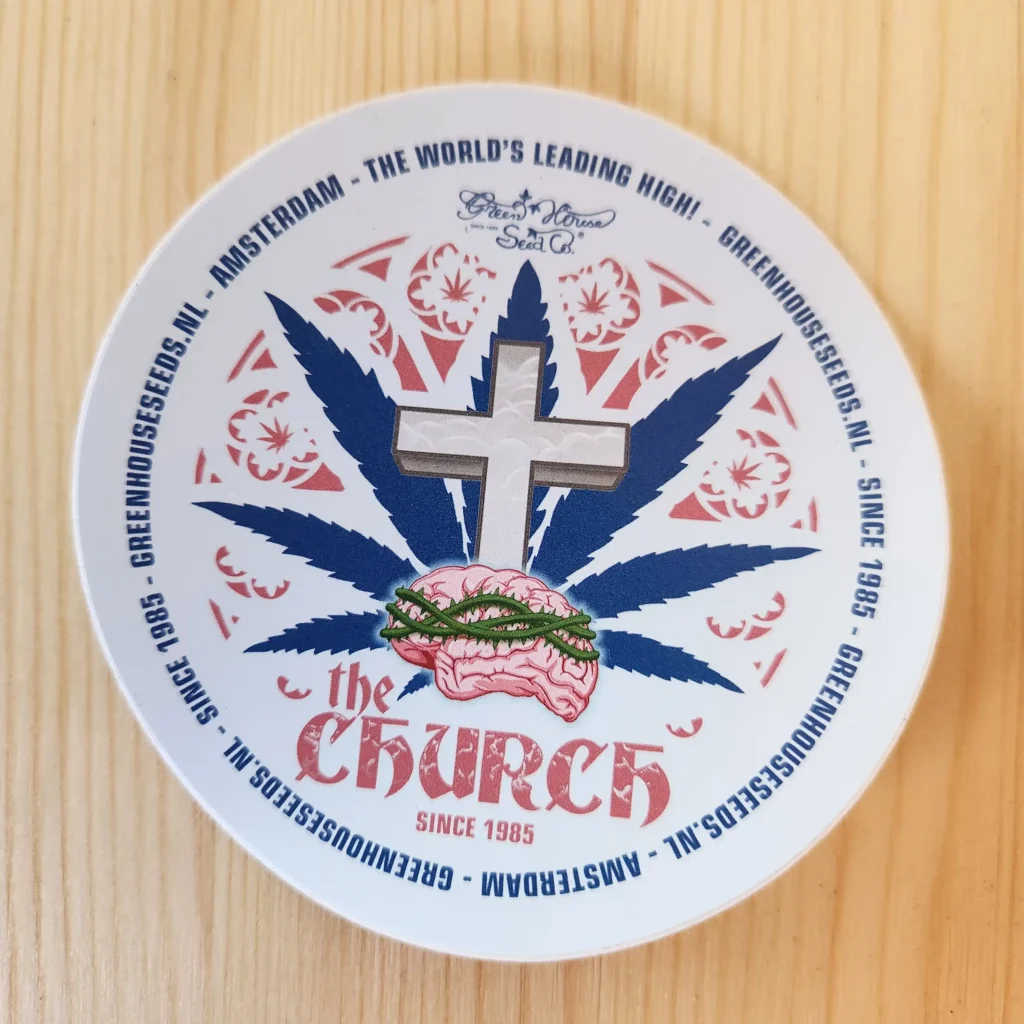
The Church
Design: Features a cannabis leaf with a cross and a stylized brain crowned with a leafy wreath, set against a white background with red details. The «The Church» text has a gothic flair.
Theme: Suggests a revered status for cannabis, perhaps alluding to a spiritual experience from the strain.
Aesthetic: The white-and-red contrast offers a clean yet intriguing style, ideal for those who appreciate symbolism.

White Widow
Design: A spider in a web hovers over a green cannabis leaf on a black background, framed by the logo and «Since 1985» text.
Theme: References the famous White Widow strain, with the spider symbolizing its power and mystery.
Aesthetic: The dark palette with vivid green accents delivers a sleek, minimalist vibe, perfect for thematic decor.

Wonderpie
Design: A superhero-style woman holding a pie stands out on a blue background accented with red and yellow details. The «Wonderpie» text pops vividly.
Theme: A playful twist on «Wonder Woman» and «pie,» possibly indicating the strain’s flavor or effect.
Aesthetic: Bright and cheerful with a pop-art feel, designed to catch the eye.
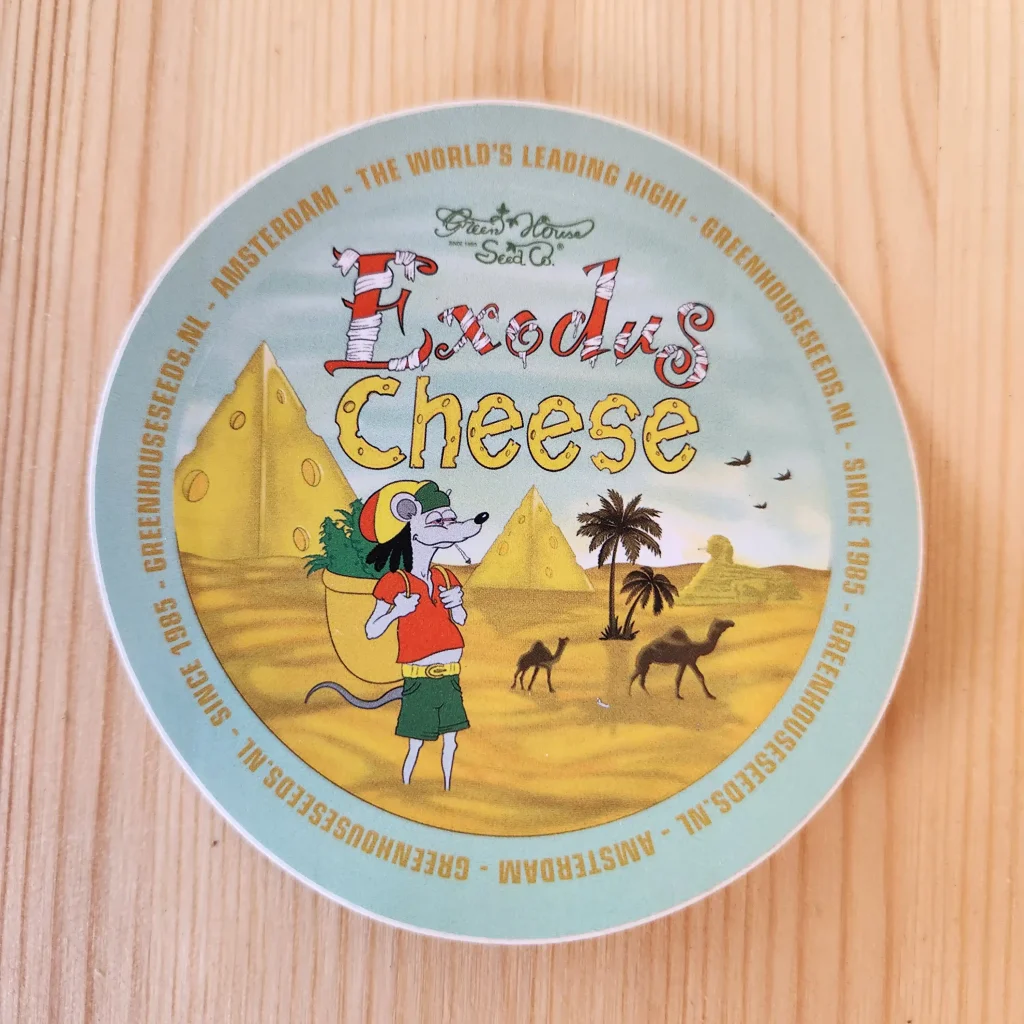
Exodus Cheese
Design: A cartoon mouse with a cheese wedge and Egyptian pyramids adorns a light green background. The «Exodus Cheese» text shines in bold colors.
Theme: Ties to the Exodus Cheese strain with a humorous Egyptian twist, perhaps nodding to its ancient origins.
Aesthetic: Lighthearted and playful with warm tones, fitting for a relaxed setting.
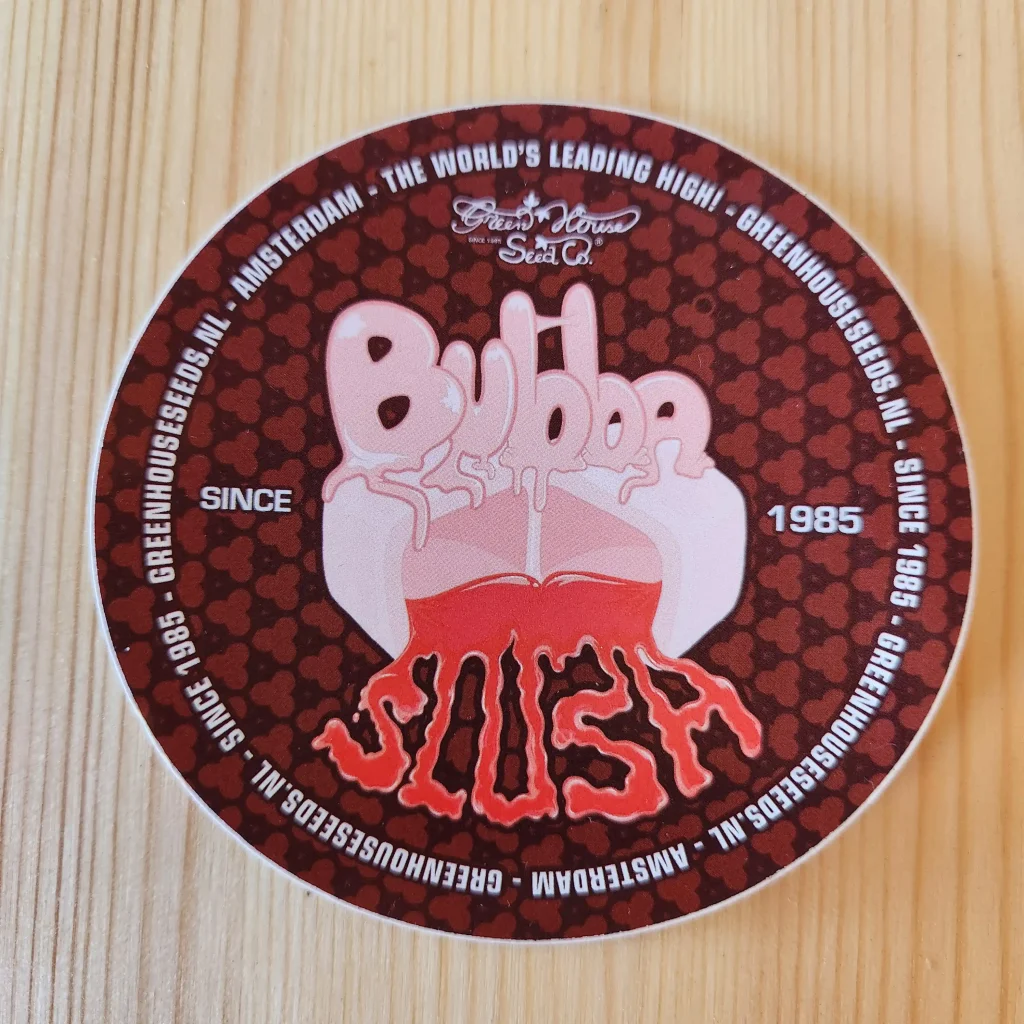
Bubba Slush
Design: An abstract image featuring drips and a mouth on a pink background with red accents. The «Bubba Slush» text stands out sharply.
Theme: Might reflect a refreshing or sticky strain effect, emphasizing texture.
Aesthetic: Unusual and daring, its originality draws attention.
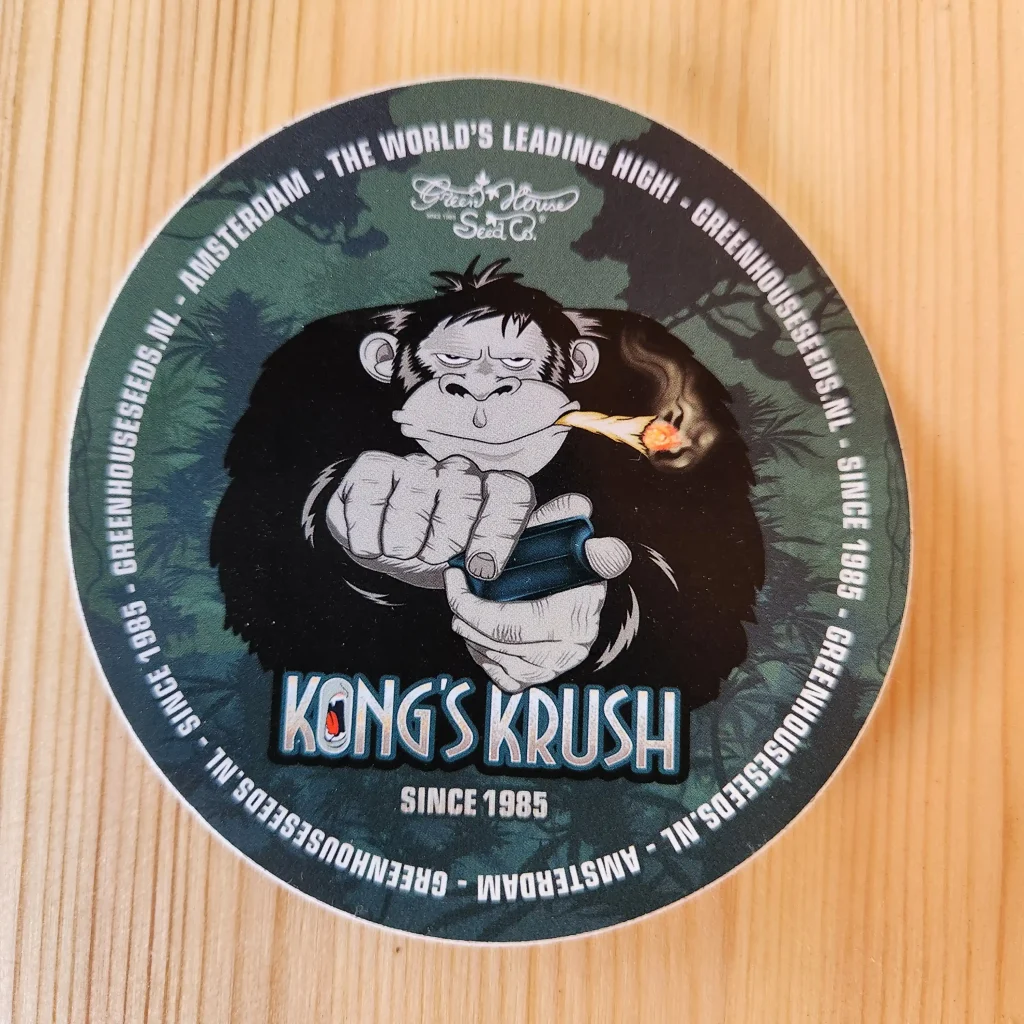
Kong’s Krush
Design: A gorilla holding a cigarette is depicted on a green background with plant motifs. The «Kong’s Krush» text is rendered in a bold style.
Theme: The gorilla’s powerful image symbolizes the strain’s strength, hinting at a strong effect.
Aesthetic: Deep green tones with black accents offer a rugged yet stylish appearance.
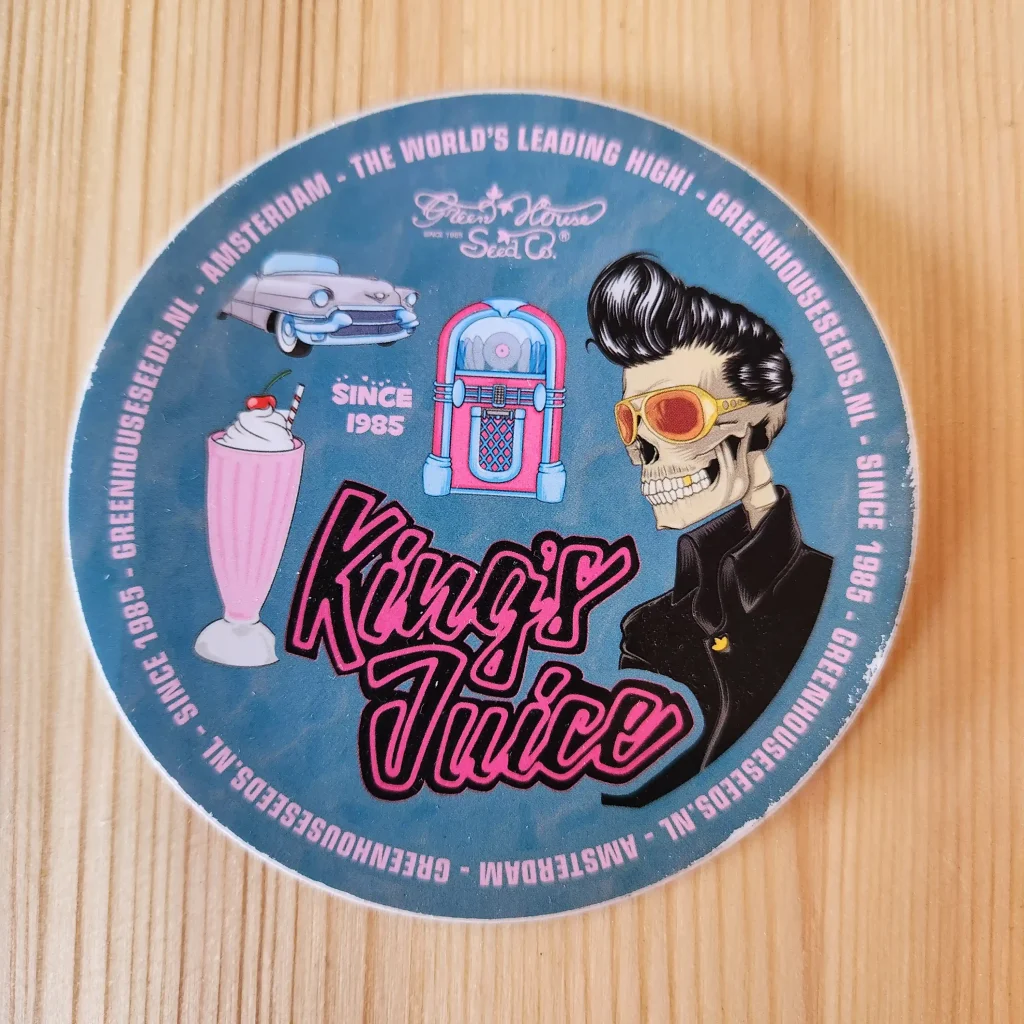
King’s Juice
Design: A rockabilly skeleton with a milkshake and retro car graces a blue background. The «King’s Juice» text glows in neon pink.
Theme: A retro vibe with a «juice» reference, possibly alluding to the strain’s taste or potency.
Aesthetic: Bright and nostalgic, perfect for fans of vintage aesthetics.
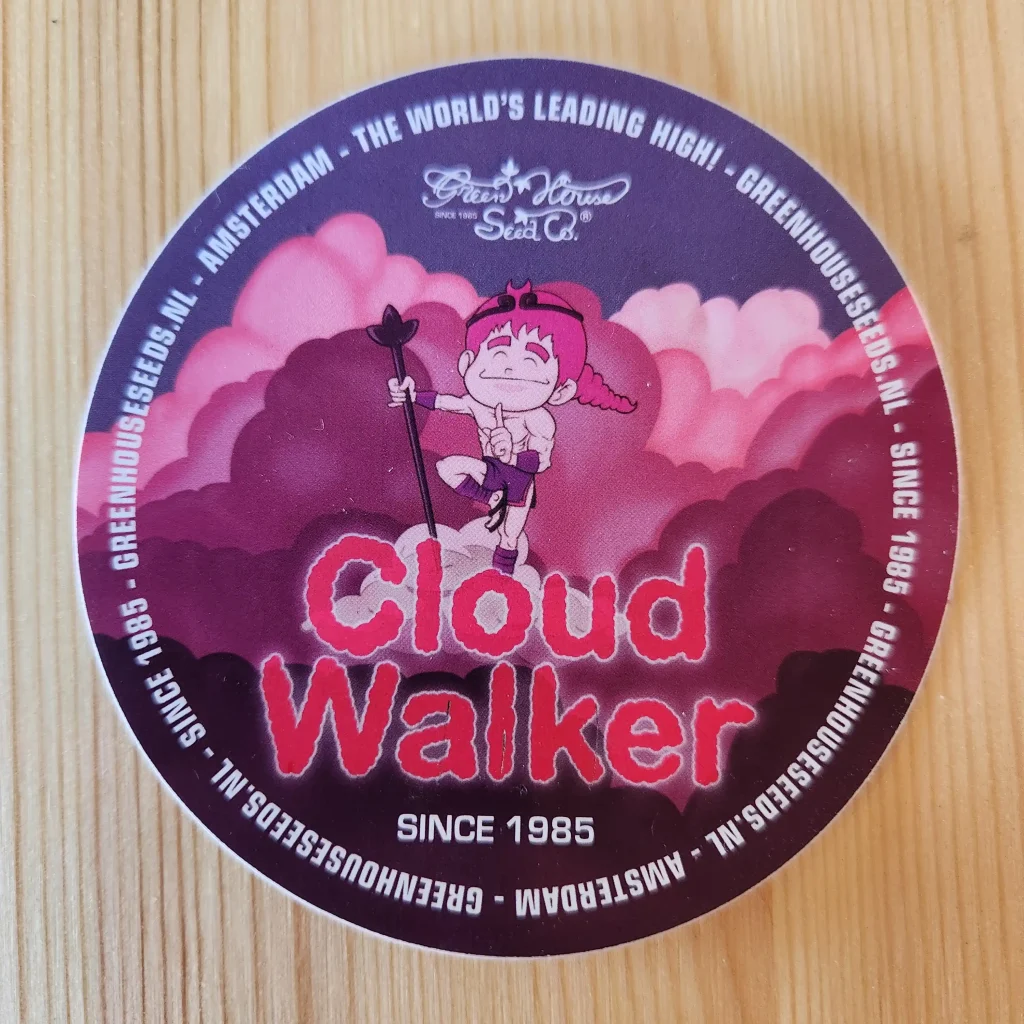
Cloud Walker
Design: A cartoon character with a staff floats among clouds on a purple-pink background. The «Cloud Walker» text is in red.
Theme: Evokes a cloud-traveling figure, possibly linked to the strain’s lightness or psychedelic qualities.
Aesthetic: Soft pastel shades with a playful style, appealing to a broad audience.
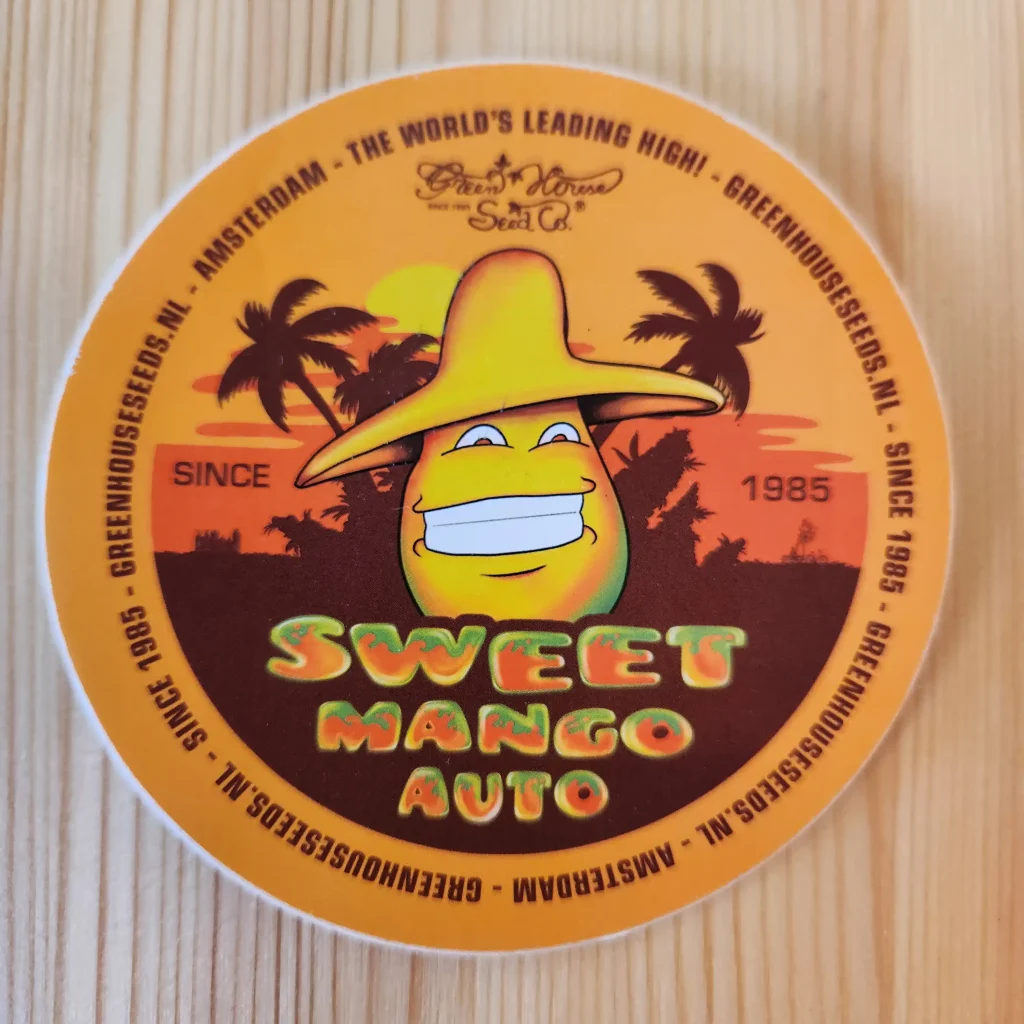
Sweet Mango Auto
Design: A grinning mango in a sombrero lounges under palm trees with a fiery sunset, with «Sweet Mango Auto» in gooey orange-green letters, encircled by Amsterdam branding and «Since 1985».
Theme: Captures tropical sweetness and auto-flowering ease, hinting at a juicy, hassle-free strain.
Aesthetic: Bright and sunny with a tropical twist, appealing to fruit lovers and casual users.
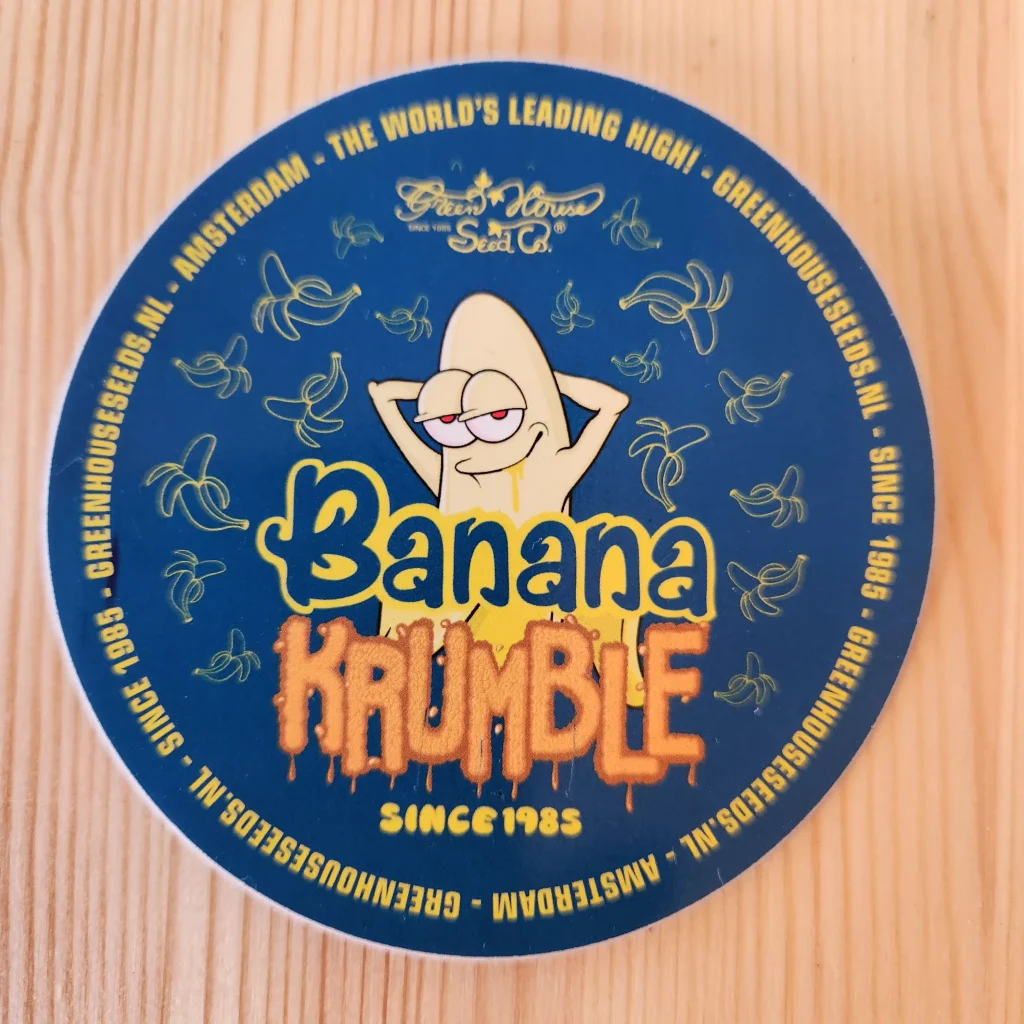
Banana Krumble
Design: A chill banana character lounges with red-rimmed eyes, surrounded by peels on a starry blue background, with «Banana Krumble» in melty yellow-orange and Green House details around the edge.
Theme: Suggests a relaxing, crumbly indica experience with a stoner humor twist.
Aesthetic: Laid-back and quirky with deep tones, attracting laid-back enthusiasts.

Big Bang
Design: A gray alien puffs a joint and holds a «MK X» spray can, with UFOs and stars on a black cosmic background, «Big Bang» in jagged white, circled by Amsterdam and «Since 1985».
Theme: Represents a universe-shattering high, ideal for a potent, mind-blowing strain.
Aesthetic: Out-of-this-world and bold, drawing in space-loving smokers.

Holy Snow
Design: A tiki god surfs a snowy wave with a shaka sign, amid palm trees and icy peaks on a blue beachy backdrop, «Holy Snow» in fiery orange, with Green House branding around.
Theme: Blends tropical heat with snowy sativa power, hinting at a divine, energetic strain.
Aesthetic: Vibrant and adventurous, appealing to surf and snow enthusiasts alike.

Chemical Bride
Design: A seductive woman with pink flaming hair and a rose crown sticks out her tongue on a toxic green background, «Chemical Bride» in dripping purple, encircled by «Since 1985» and Amsterdam details.
Theme: Suggests a potent, gothic chemical romance, perfect for a strong, unique strain.
Aesthetic: Edgy and captivating with dark tones, attracting bold collectors.
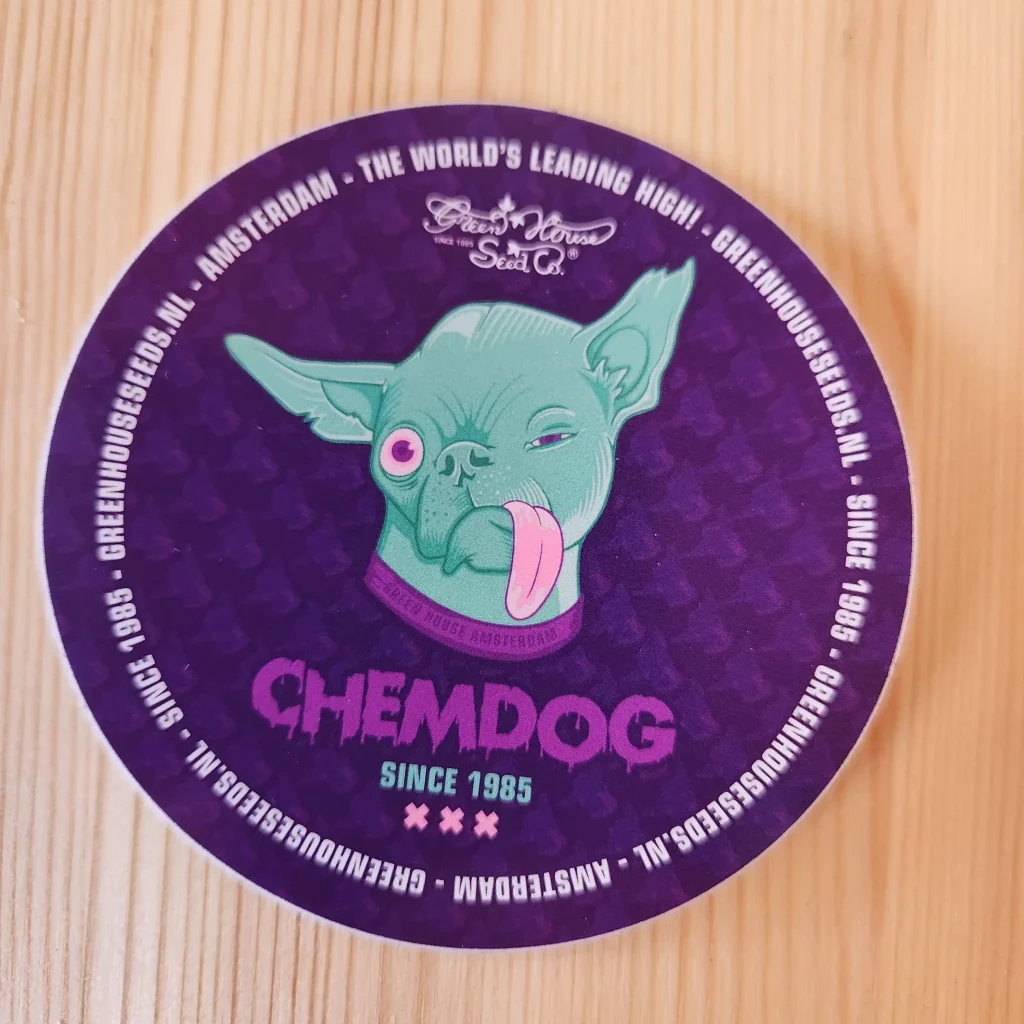
Chemdog
Design: A green funny goblin-dog with one eye winks and sticks out its tongue on a purple leopard-print background with hearts, «Chemdog» in pink graffiti, circled by Amsterdam and «Since 1985 xxx».
Theme: Embodies the legendary chem strain with a wild, rebellious energy.
Aesthetic: Freaky and fun with vibrant colors, appealing to chem strain fans.

Hawaiian Snow
Design: A snow-capped tiki idol smokes a rainbow joint on a navy night sky with a cannabis leaf, «Hawaiian Snow» in white with a fiery trail, encircled by «Established in 1985»
Theme: Combines Hawaiian fury with snowy sativa strength, hinting at an intense experience.
Aesthetic: Intense yet inviting with tropical and starry vibes, perfect for adventurers.

Flowerbomb Kush
Design: A massive yellow mushroom cloud erupts over a skyline of classic Amsterdam buildings, with «Flowerbomb Kush» exploding in vibrant red and green graffiti-style letters. The Green House Seed Co. logo and «Since 1985» circle the edge, adding a touch of heritage to this explosive scene.
Aesthetic: Bold and intense with a dark, smoky vibe, blending urban chaos with cannabis potency—perfect for fans of powerful strains and gritty art.

Jack’s Dream
Design: A suave, bearded Jack Herer figure in a fedora holds a joint, surrounded by swirling smoke and leafy accents on a sleek black background. «Jack’s Dream» stands out in bold white letters, with «Since 1985» and Green House branding encircling the edge.
Aesthetic: Sophisticated yet trippy with a noir-inspired coolness, appealing to those who savor a smooth, dreamy high with a touch of class.
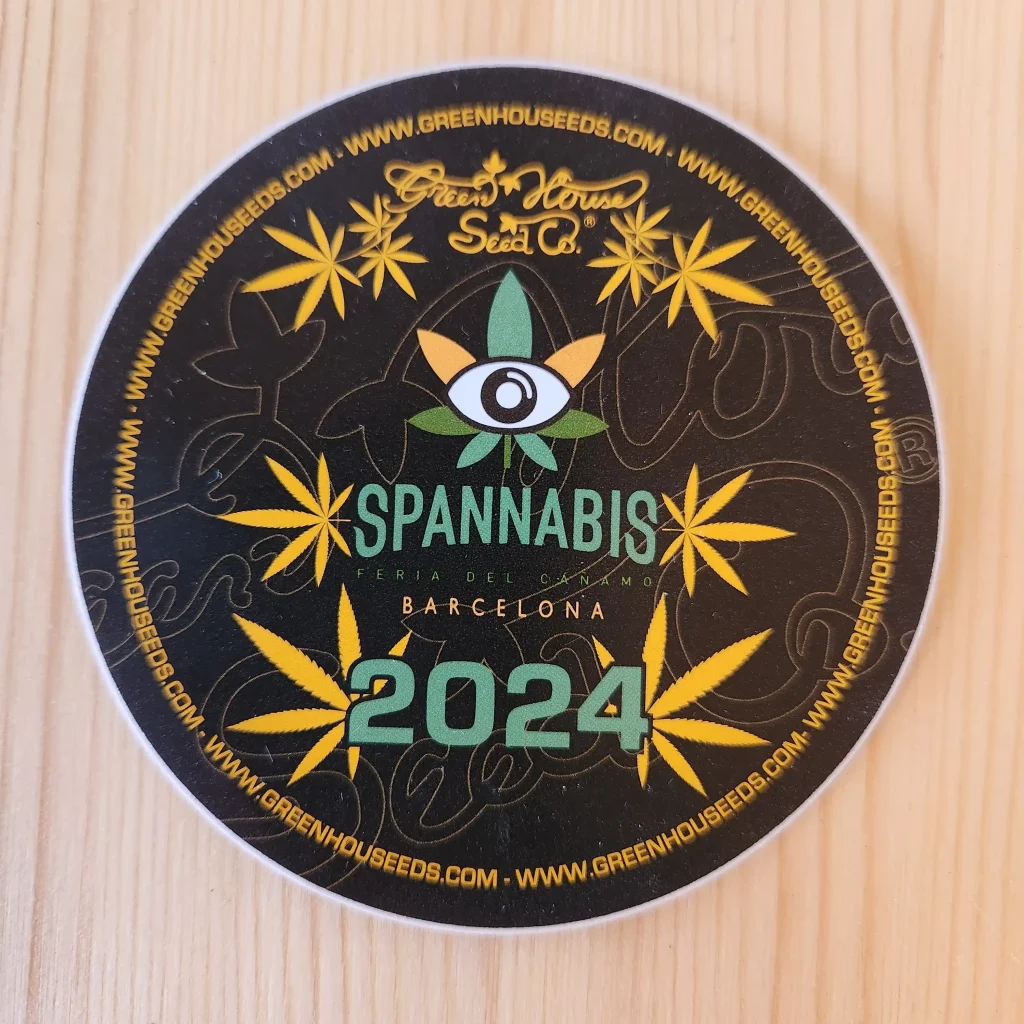
Spannabis 2024
Design: A stylized cannabis leaf with a watchful eye at its center anchors a black backdrop, surrounded by golden leaves and the text «Spannabis 2024 Fería Cannabis Barcelona» in green and yellow. Green House branding and websites circle the edge.
Aesthetic: Sleek and modern with a mystical, all-seeing vibe, perfect for cannabis event enthusiasts and collectors marking the 2024 Barcelona fest.
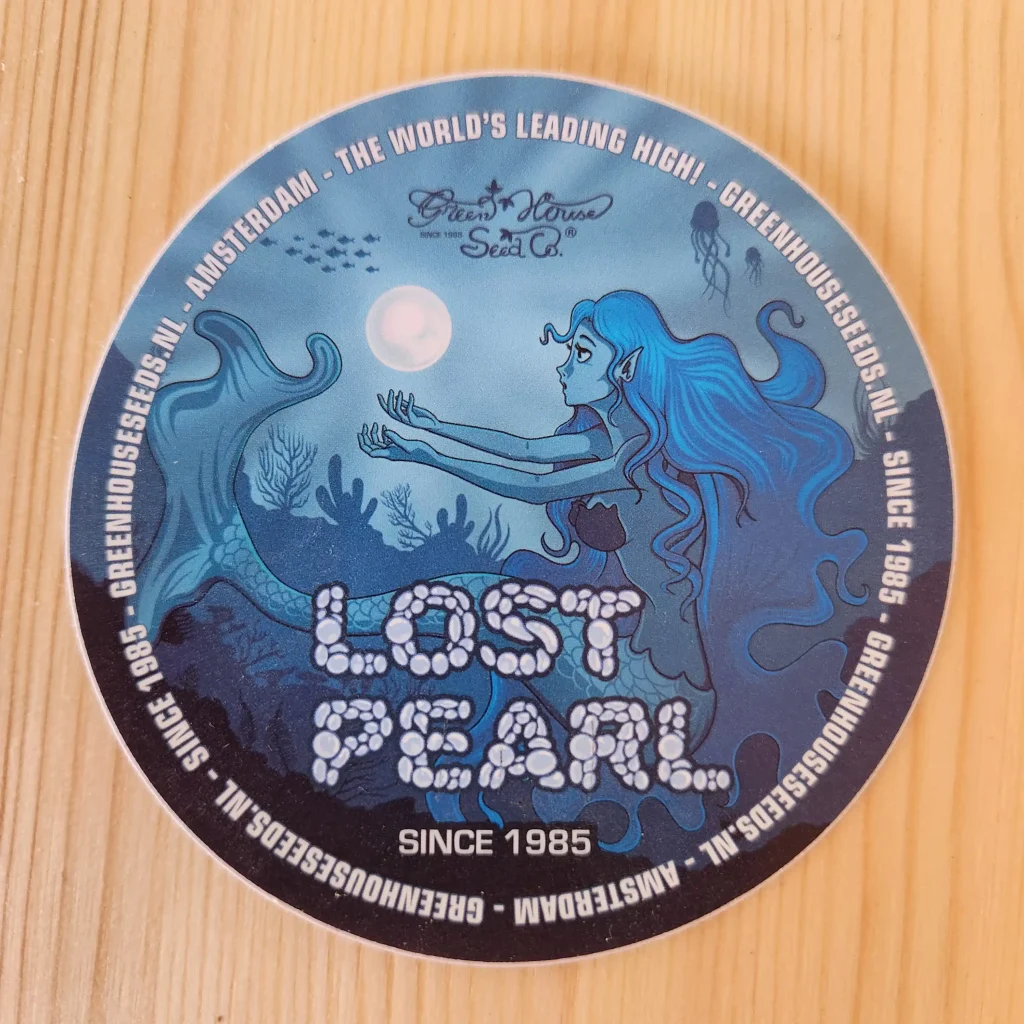
Lost Pearl
Design: A mystical mermaid with flowing blue hair reaches for a glowing pearl under a moonlit ocean, surrounded by jellyfish and waves. «Lost Pearl» shimmers in white, with «Since 1985» and Green House details framing the underwater scene.
Aesthetic: Ethereal and enchanting with deep blue tones, ideal for those drawn to rare, oceanic-inspired strains and dreamy aesthetics.

Feeding+
Design: A bold QR code sits center stage with «Feeding+ Scan for our Feeding Catalogue» in yellow, set against a colorful, abstract background with award-winning plant feeding laurels. Green House Feeding branding circles the edge.
Aesthetic: Practical yet vibrant, blending tech-savvy utility with a grower’s pride, appealing to cultivators seeking top-tier feeding tips.
General Observations
All stickers use vinyl, ensuring water resistance and longevity. Approximately 7-10 cm in diameter, great for decorating laptops, bottles, or grow equipment. Each sticker connects to a specific strain, featuring «Green House Seed Co.» and «Since 1985» to highlight the brand’s heritage.
Target Audience: Growers, collectors, and cannabis enthusiasts will enjoy the variety, from cartoonish to gothic and retro styles. These stickers beautifully capture the essence of Green House Seeds, blending creativity with a strong tie to their products.
Green House Seeds has long expanded its brand beyond seeds, releasing an extensive line of merch. The first examples appeared in the 1990s and 2000s, when the company was gaining popularity thanks to coffee shops and the High Times Cannabis Cup, but a full-fledged collection took shape in the 2010s with the Strain Hunters project.

Over the years, the team has released dozens of items, focusing on clothing, smoking accessories, and limited collaborations. The merch highlights the brand’s beauty: logos featuring weed leaves, slogans like «Creators of Champions» (a reference to cup victories), and the theme of Strain Hunters’ travels.
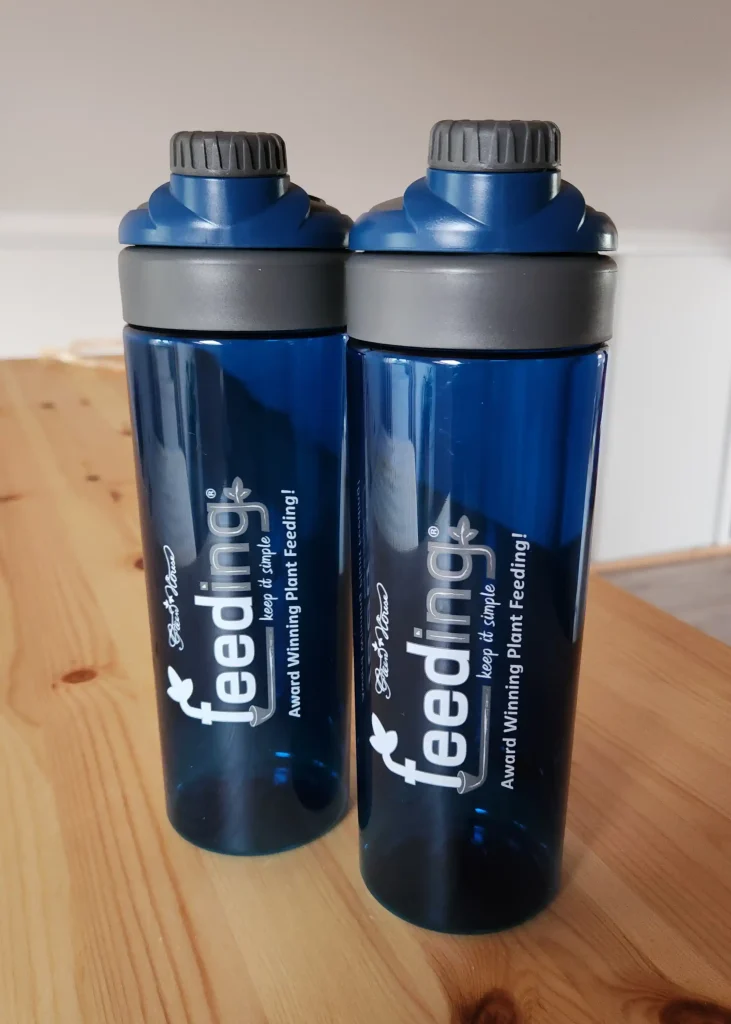
Many items are limited edition, and some older designs were only released once. Prices range from €2-3 for small accessories to €80-100 for premium clothing. While this isn’t exactly cheap, discounts of up to 15-20% are common. Sales are conducted through the official website shop.greenhouseseeds.nl and resellers like Attitude Seedbank. There are no exact figures on the number of souvenirs, but the catalogs show around 50-60 unique designs over the years.

Clothing
- Originals T-Shirts: Basic T-shirts with the «Green House Seeds Co.» logo front and back. Design: Classic script font in gold or white on a black or white background; sometimes with leaves. Material: Cotton. Price: €19.50–€24.50. Standard, available since the 2000s; color variations: black, white, gray.
- Female T-Shirts: Women’s versions of the originals, fitted cut with a V-neck. Design: Similar to men’s, but with feminine prints: flowers, haze motifs. Price: €19.50–€24.50. In the catalog since the 2010s; limited edition for specific strains.
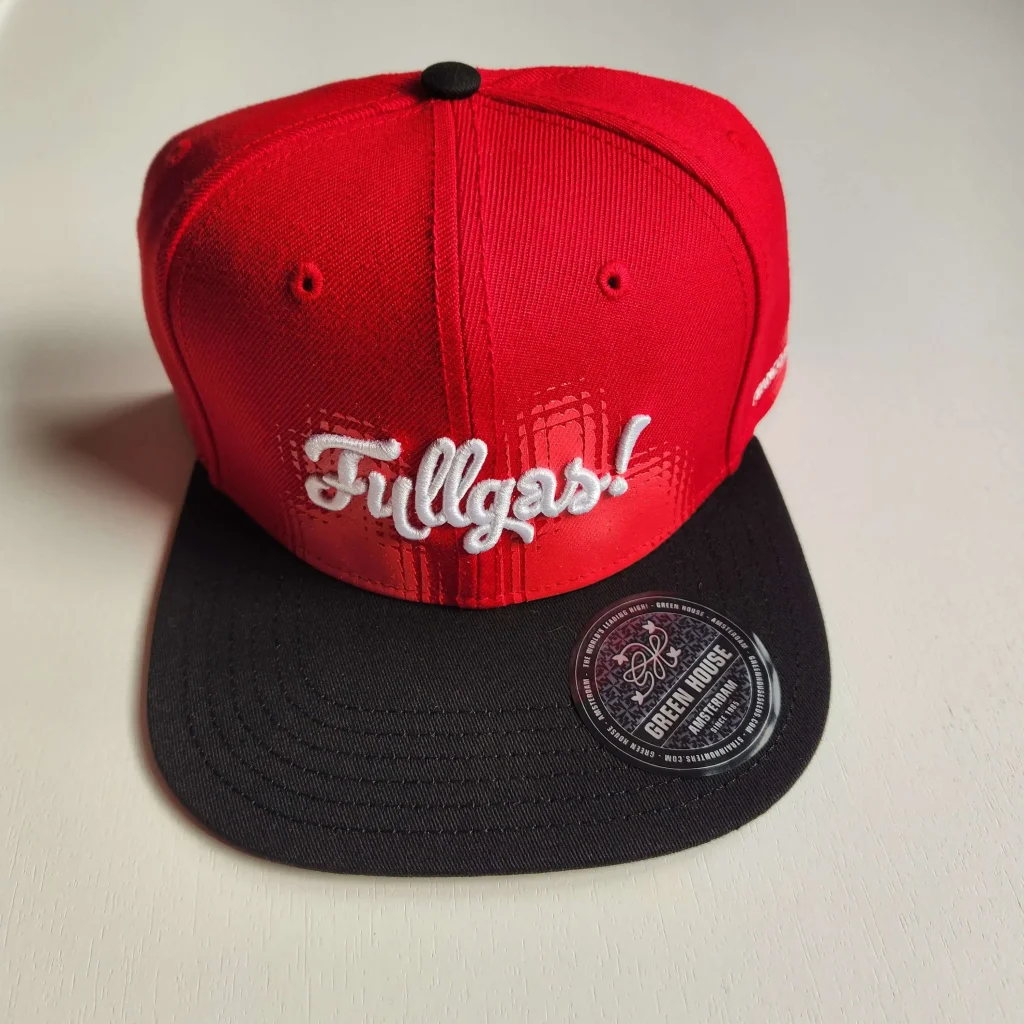
- Creators of Champions T-Shirts: A series with the «Creators of Champions» slogan and trophies. Visual: gold text, cannabis leaves. Colors: black, blue, gray. Price: €24.50–€32.50. The series was launched around 2015; has been reissued many times.
- • Limited Edition T-Shirts: Limited designs, often featuring cannabis strains or national motifs. Visual: graphics with cars and leaves. Colors: light blue/black. Price: €32.50. Produced in batches; archived models can be purchased on eBay for €20–€40.

- Hoodies Originals/Special Edition: Hoodies with a logo on the back and chest. Visual: black with gold «Green House Amsterdam» script; cannabis patterns. Price: €49–€85. Since the 2000s; cannabis versions are limited, gray-purple variations.
- Creators of Champions Hoodies: Hoodies from the champions series, with a large print. Visual: gray-purple gradient, «Champions» text. Price: €65–€85
- Limited Edition Camo Hoodies: Camouflage hoodies. Visual: green and gray mix with logo. Price: €75–€85. Older patterns are marked down to €50–€70.
Headwear - 6-Panel Hats/Snapbacks: Six types of caps with adjustable closures and logo. Price: €35
- Bucket Hats: Panama hats. Visual: green, black, and blue with logo. Price: €35
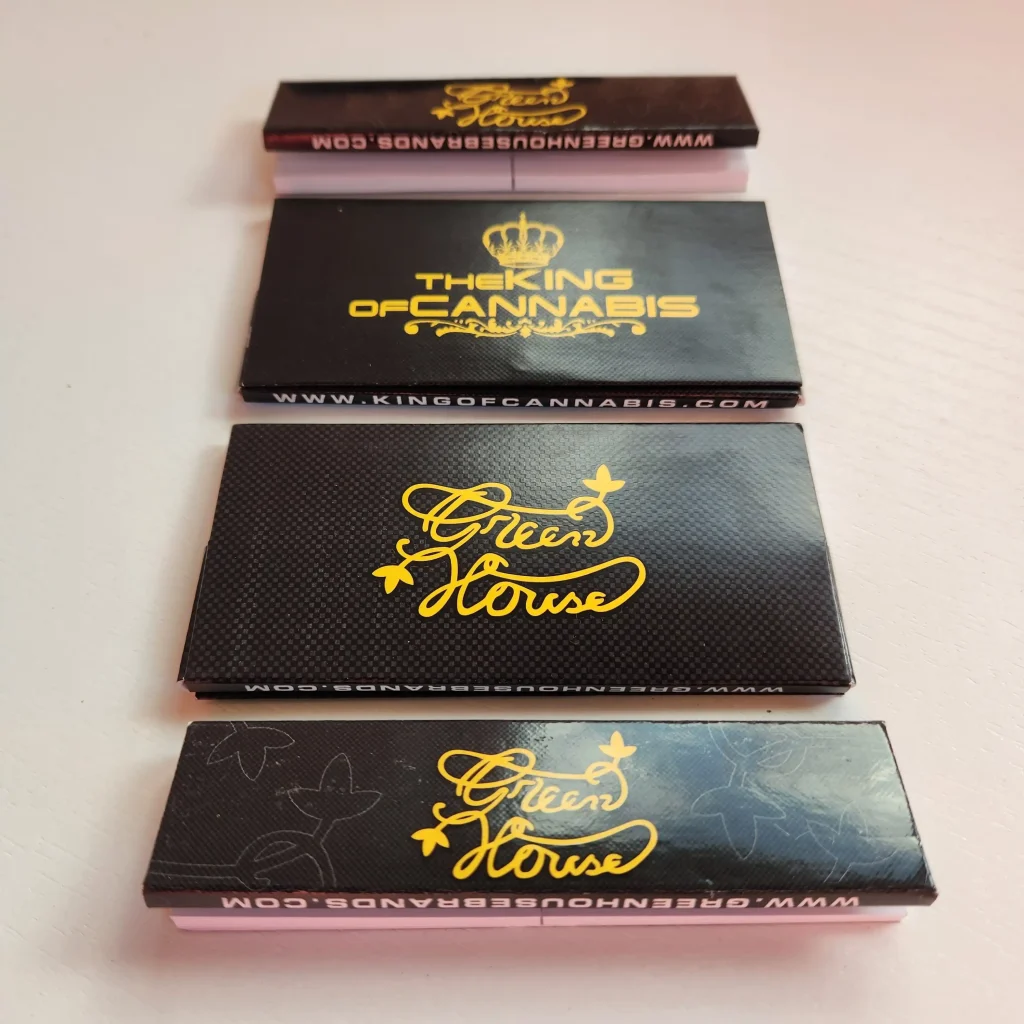
Collaborations
- Patta x GH T-Shirts/Hoodies: collab with Patta (streetwear). Visual: «The World’s Leading High since 1985» in gold; black/purple, pocket logo. Price: T-shirts €32.50–€60, Hoodies €85. Launched in 2022; sets cost €50–€100.
- Propaganda x GH T-Shirts: collab with Propaganda. Visual: gradient design with cannabis and a snake; purple/pink on black. Price: €49.
Accessories and souvenirs - Rolling Papers (Strain Hunters): rolling papers. Price: €3. Since the 2010s; Various colors, but more expensive, €5 each.
- Ultra Thin Cones — King Size: Smoking cones. White or clear joints with branding. Price: €2.50.
- Grinders (Strain Hunters): Weed grinders. Metal with logo or plastic. Price: €15–25. Limited editions and archival releases are sold on eBay for €10–20.

- Lighters. Plastic with logo or strain prints. Price: €5–10.
- DVDs (Documentaries/Grow Sessions): Videos of Strain Hunters expeditions. Covers with Arjan Roskam in the jungle. Price: €10–20.
- Value Packs: sets: t-shirt + hat + accessory. Branded set. Price: €50–80. A great gift for fans; includes stickers for older versions.
- Stickers: Souvenir stickers with logos and brands. Vinyl, round and rectangular, price: €1–€5.
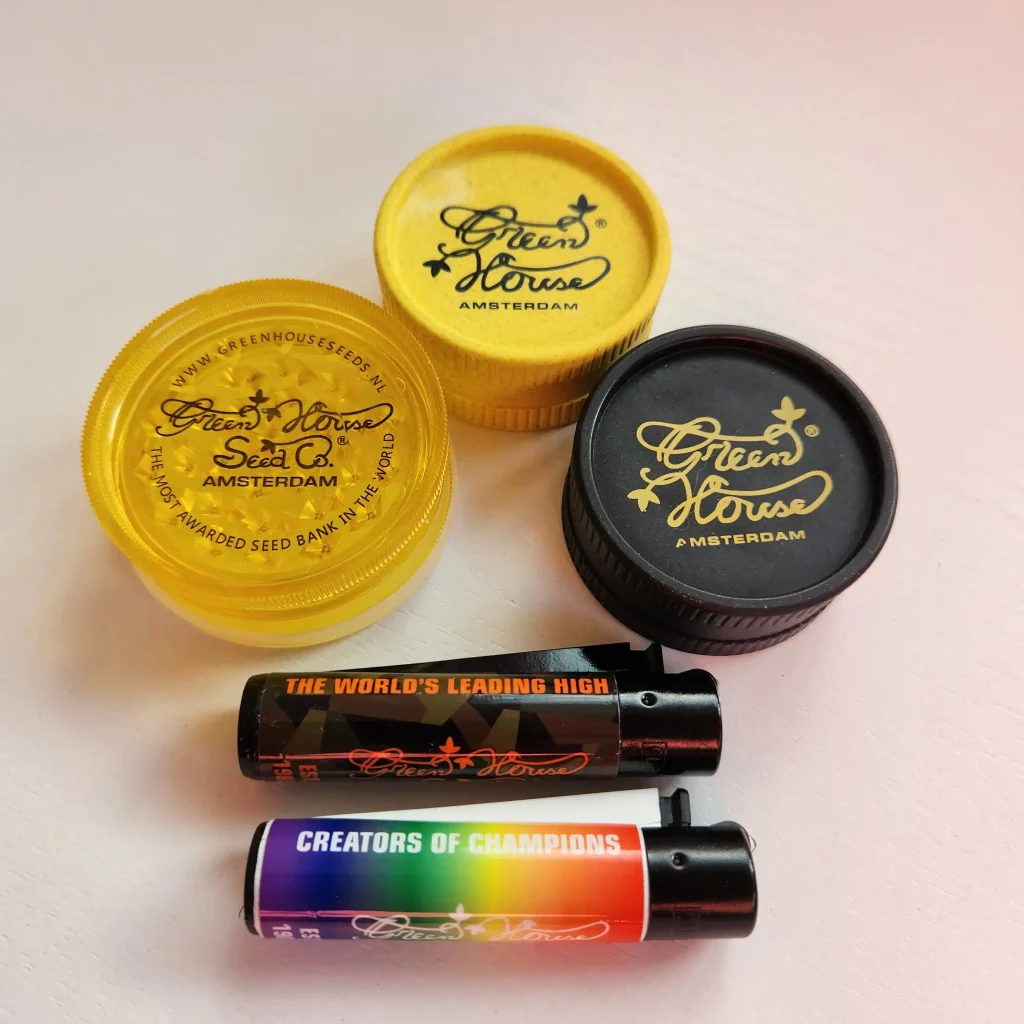
White Rhino
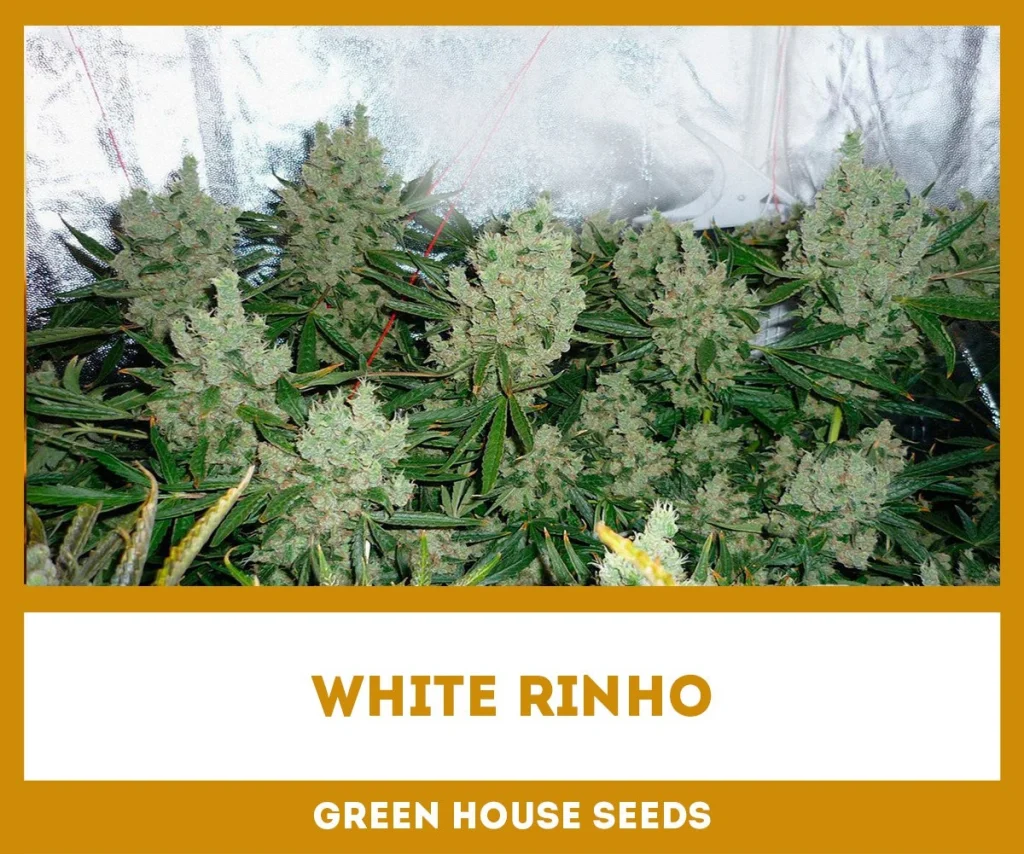
Seedbank: Green House Seeds
Variety: White Rinho
Room type: indoor
Growbox dimensions (cm): 200x100x100
Substrate: Biobizz Coco Mix® coco
Fertilizers: Advanced Hydroponics of Holland
Light: 400W HPS for vegetative growth, 600W HPS for flowering
#indoor #coconut #HPS #advancedhydro
There are two photoperiod seeds from Green House Seeds. Grow equipment: I’m planning to keep the plants in the vegetative stage for three weeks, but I read that Dutch seeds grows very rapidly during the pre-flowering stage, so we’ll see. I named the plants Belka and Strelka, as this is my first time growing under photoperiods.
4 days: I watered them with 150 ml of «Amber Crab,» a rooting, growth, and immunity activator. It seems to be off to a good start!

9 days: 31°C outside, 28-29°C inside the box. I applied «Beta Factor» to the leaves, a stimulant that effectively controls various stressful situations. I haven’t fed them yet; the coco coir is buffered at 900 ppm.
14 days: The yellowing of the leaves is a bit concerning. I poured 3 liters of water up to the drainage to measure it. Inlet pH 5.7, 180 ppm, outlet pH 6.4-6.6, 700-800 ppm. Nothing out of the ordinary, so we’re still growing.
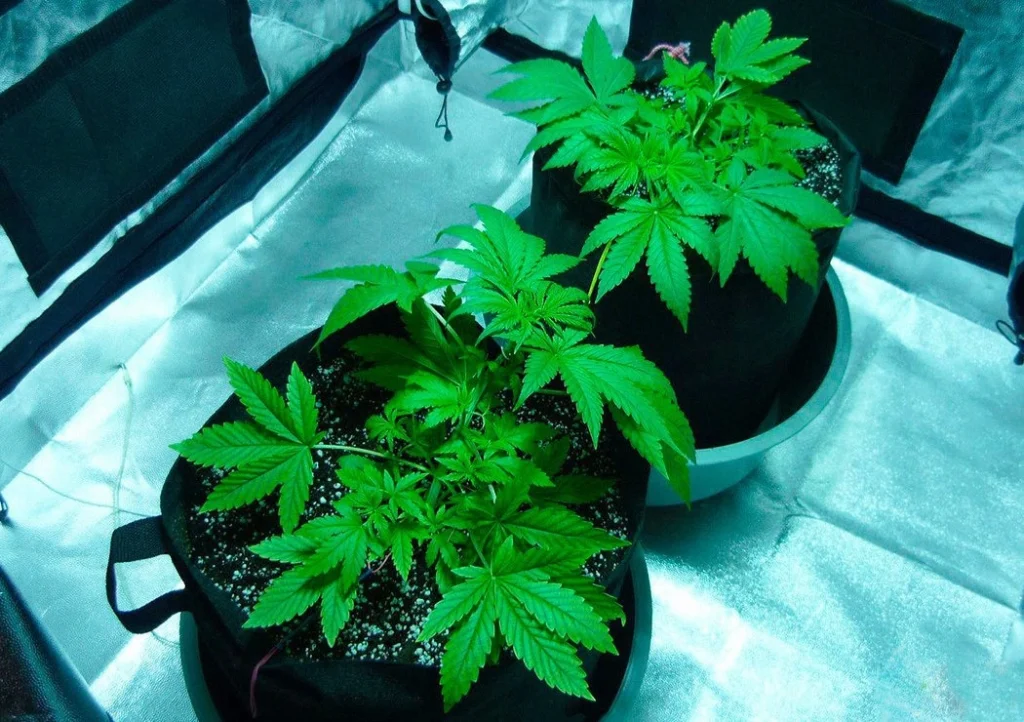
20 days: The pH level is a bit high on the drainage, so I’m now watering with a pH of 5.5, maybe even 5.0. I poured 2 liters of water at 750 ppm. Overwatering is my main problem, although it’s very difficult to overwater with coco in cloth bags. The distance to the lamp is 40 cm.
22 days: I started using LST, bending it a bit. I poured 3 liters of water, and the outlet pH is 700 and 900 ppm, respectively.
29 days: I evened things out, and the drainage pH is slightly higher than the inlet pH. Inlet pH 750-760, outlet pH 720-730. We’re feeding and growing, and the pH is perfect—6.2.
34 days: I changed the lighting – now I have 600W HPS. I’m doing some exercise. I need to increase the fertilizer dose; they’ve been eating very actively lately.
41 days: Switched to flowering mode, 12/12. Pre-flowering has begun, with 830 ppm at the entrance, and 600-650 ppm at the exit.

49 days: Eight days after switching to flowering mode. Appetite is excellent – I’m watering at 950 ppm, with 650-680 ppm at the exit. I need to thin them out; a lot of small shoots have grown. I’ll wait until they reach full flowering; it’s best to leave them alone during the pre-flowering stage.
The branches have almost filled the entire width of the box; there are only two small corners left; there’s not even room for another fan!
56 days: I left them on 11/13 for four days to speed up the transition to flowering, then returned them to the standard 12/12. I’ll trim off all the little things at the bottom in a few days; the light isn’t getting through anyway.

64 days: Humidity is 70%, the radiators should be turned on soon, and things will improve—it’s recommended to keep it at 30-40% during flowering. They’ve grown so big that it’s hard to get to the sides. I trimmed the bottoms of the plants and pulled off the big shoots. I’m thinking about making a drop plant.
I’m bending them and stretching them, since we don’t need them to grow any further; the lamp is about 20 centimeters away. After I trimmed them, I don’t see any stress. I broke a couple more stakes today; we’ll see how quickly they recover. I’m starting to think this tent is too small for two cameras; 120 is needed at least.
70 days: We’ve been flowering for two weeks. They drink 4 liters a day. I gave them some pre-mixed ACh two days ago; the pH and PPM of the drainage water have been adjusted for both plants. At night, they release a wave of odor throughout the house.
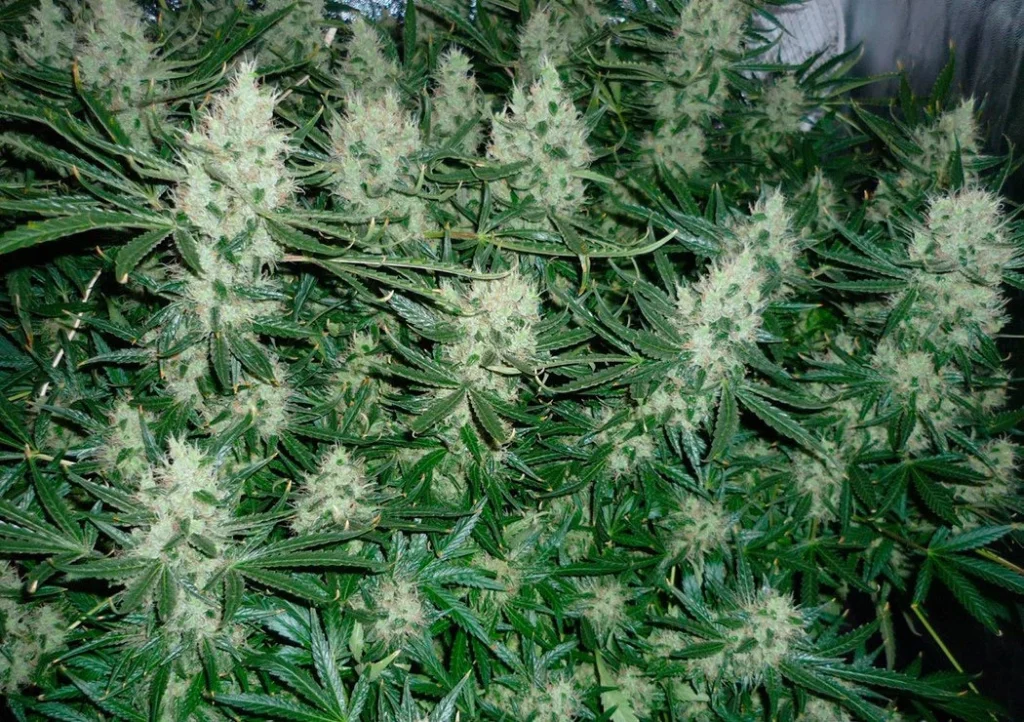
78 days: Three weeks of flowering. They’re not eating well at 600-700 ppm, which could be due to the AQC, which has caused the plants to overuse nitrogen and has also burned the leaf tips. I’m watering with 5 liters per day, and using a liter for drainage. Incidentally, after turning on the heating, the humidity dropped to 30-40%, so mold is definitely not a concern.
90 days: They’re still not eating. It’s dropped to 500 ppm, so I water every other time. The flowers are at their peak, though.
95 days: Exactly 40 days of flowering. I’ve trimmed the burdocks, removed some of the stringers, and raised the lamp almost to the ceiling. They’ve been sitting on water for three days now, not eating at all. I don’t know, maybe it’s stress from pruning.

100 days: Humidity is 35-40%, I turned on a large fan to make sure there’s no mold. I grabbed some string – it’s time to tie up the buds. Strelka is still on the water, Belka is gaining momentum. Coconut is a real pain in the ass – sometimes they eat, sometimes they don’t.
110 days: Strelka got a drop, we’re experimenting. It digs up 4-5 liters in 10 hours, with about a liter of drainage.
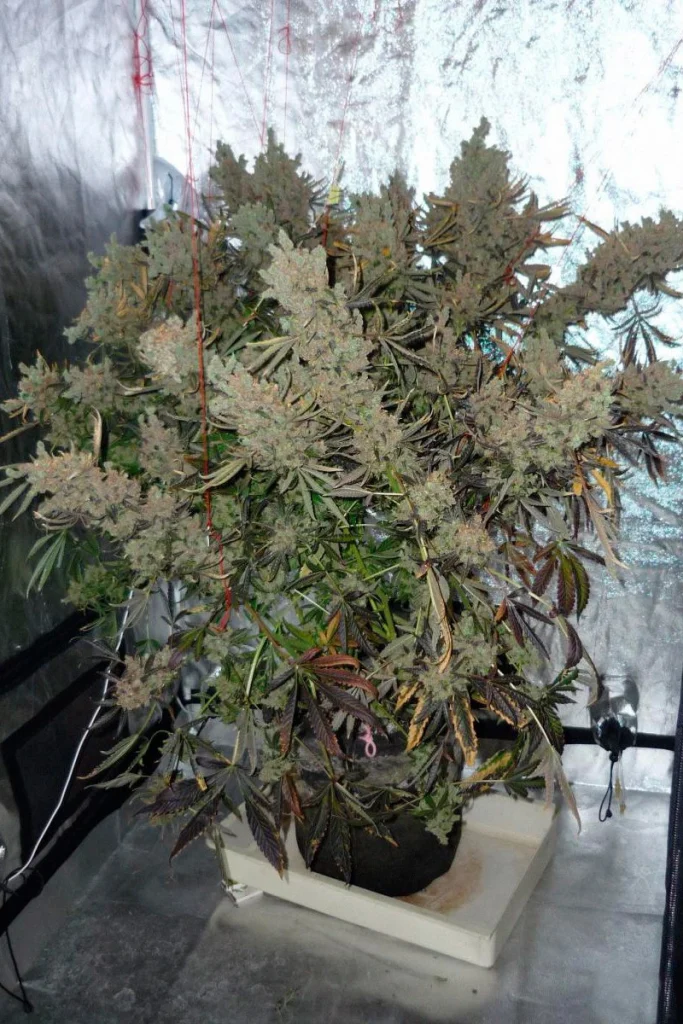
120 days: Strelka went to Ripen; enough of torturing the girl. Strelka has amber, milk, and clear trichomes. The smell, by the way, isn’t particularly noticeable.
130 days: Belka is eating and eating well. Strelka is in its last days. It smells like incense. The trichome count is simply incredible.

146 days: Harvest
Total: 159 g + 270 g = 429 grams. I did a manicure, cut along the branch, spent two evenings. Within a week, everything was crispy dry.

Green House Medical
Green House Seeds Medical is the medical division of Green House Seeds. In the early 2000s, the company expanded into the medical field through the GH Medical division and related projects, such as Green House DRC in the Democratic Republic of the Congo (DRC). The medical division’s goal is to normalize cannabis for recreational and medical use, which ultimately contributed to its legalization in many countries, including 19 US states, Uruguay, and decriminalization in Europe.
GH Medical, founded by Arjan Roskam, focuses on the medical use of cannabis. The company collaborates with universities and clinics to develop cannabinoid-based medicines. In 2018, the GH Medical Congo Project was launched to produce medicines in the Democratic Republic of the Congo. By 2025, Green House had expanded to Thailand, Canada, and other regions, adapting genetics for large-scale production, including for medical purposes.
Green House Medical’s research focuses on genetics and cannabinoids. Through Strain Hunters, they have cataloged hundreds of strains, analyzing their active compounds (cannabinoids, terpenes) for treatment. In collaboration with GH Medical, Dutch doctors are identifying combinations for specific diseases, such as malaria, AIDS, respiratory infections, and diarrhea. In the Congo, GH Medical is researching local landraces and experimenting with them to produce low-cost medications. The company is also developing high-CBD strains for medical use, available in pharmacies, such as in the UK through MedBud.
Green House Seeds produces seeds for medical cannabis, but through GH Medical and Green House DRC, this production is directly translated into full-fledged medications. In the Democratic Republic of the Congo, they are developing cannabinoid medications based on local varieties that are inexpensive to grow and low-tech. The project includes clinical trials in collaboration with universities in Kinshasa and hospitals in the country. In other regions, such as Thailand and Canada, they produce oils, extracts, and products for the medical market. Arjan emphasizes that they produce medicines for people in places where the government fails.
Green House DRC is a key project in the Democratic Republic of Congo, launched in 2018. Arjan’s team owns plantations for growing local landrace cannabis and trains farmers and medical workers. They collaborate with the DRC’s ministries of agriculture, education, and health, as well as the University of Kinshasa. In 2020, the Congolese factory fed 250 families and 700 children, focusing on sustainable production. The plantations are used to preserve genetics and produce raw materials for medicines. Strain Hunters began with expeditions to Congo in the 2010s to search for cannabis varieties, which led to the establishment of the plantations.
In addition, Green House Medical has participated in a joint project with cannabis industry giant Canopy Growth Corporation and Organa Brands, known for its brands like O.penVAPE. This is a three-pronged partnership, rather than separate projects with each company. It focuses on the production and distribution of cannabis products, including medical ones, using Green House genetics and Organa Brands’ extraction technologies. The project is being implemented through a joint venture (JV) with Agripharm Corp., a licensed cannabis producer in Canada. The JV agreement was signed in November 2017, following the legalization of cannabis in Canada, where the recreational market opened in 2018. Previously, Agripharm was a wholly owned subsidiary of Canopy Growth, but under the JV, Canopy’s stake was reduced to 40%, Green House received 40%, and Organa Brands 20%.
The JV produces cannabis products based on Green House Seeds genetics, using CO₂ extraction technology for oils and infused products. The company’s product range includes:
Dry cannabis buds;
Cannabis oils and extracts
Other products (value-added), such as infused forms for consumption, capsules, vaporizers, and edibles.
Production is tailored for the medical and recreational markets, with a focus on medical applications: pain relief, anxiety relief, and infection relief. Agripharm is licensed to manufacture and sell up to $31.25 million annually.
Production takes place at Agripharm’s facility in Cremore, Ontario. Specific prices for JV products are not published, but general prices for cannabis products range from $6 to $12 per gram of dry cannabis. Oils and extracts range from $20–50 per ml or unit, depending on the CBD/THC concentration. Organa Brands vapes and extracts range from $30–80 per cartridge or vial. These prices vary by region, taxes, and regulations, and are current as of 2025.
The primary market is Canada (medical and recreational cannabis). JV also plans to expand into international markets: Germany, the UK, Australia… Green House and Organa products are distributed exclusively through Canopy in Canada, through Canopy’s online platforms (Tweed Main Street for medical cannabis), provincial retail chains, and wholesale to other licensed producers. In international markets, they are distributed through partners and pharmacies, such as Tweed in Germany.
Currently, there is no information on JV’s current revenue for 2025, but the project is considered a successful entry for Green House and Organa into the Canadian market, with potential for global growth. JV remains active, furthering Green House Medical’s global influence in cannabinoid medicine, although its focus has shifted to other Canopy initiatives after the 2020s.
In short, GH Medical continues to expand, and their overall commitment to medical cannabis—from genetics to local production—makes Green House Seeds a pioneer in the industry.
Green House Feeding fertilizers are designed for cannabis cultivation and are focused on ease of use, high concentration, and effectiveness. An important part of the company’s ecosystem, they were developed with a focus on mineral and organic formulas to simplify the growing process without sacrificing quality.
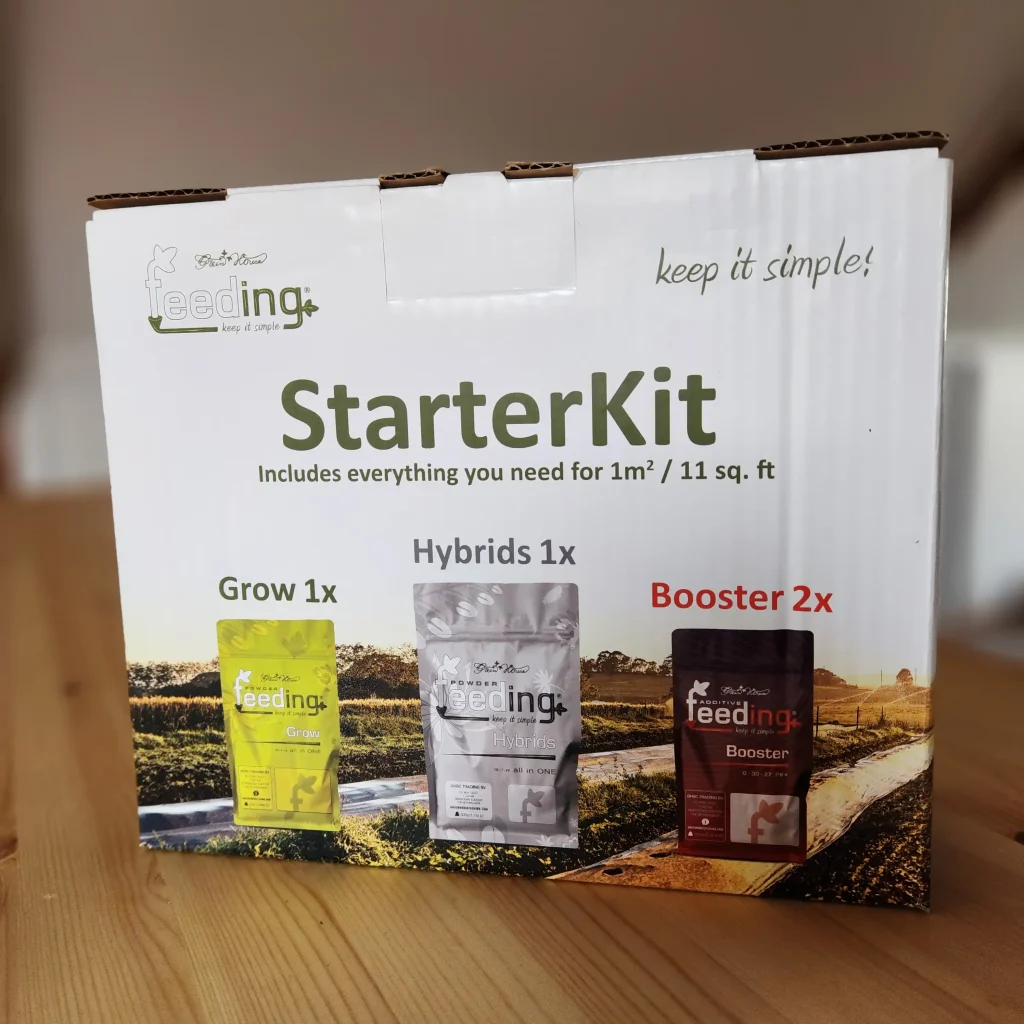
Green House Feeding fertilizers are available in powder form, making them easy to store, transport, and use, and offering a longer shelf life than liquid fertilizers. The main ingredients are sourced from Germany and Switzerland, where high quality standards are maintained.
Green House Feeding offers a range of high-quality fertilizers designed for various plants, including cannabis, tomatoes, and vegetables. Developed by Green House Seeds, these products cater to both mineral and organic growing methods, ensuring robust plant development across all growth stages. This guide explores the Mineral Line and Organic Line (Bio Feeding), detailing their composition, applications, benefits, and considerations for growers. Whether you’re a beginner or an experienced cultivator, these fertilizers simplify nutrition while maximizing yield and quality.
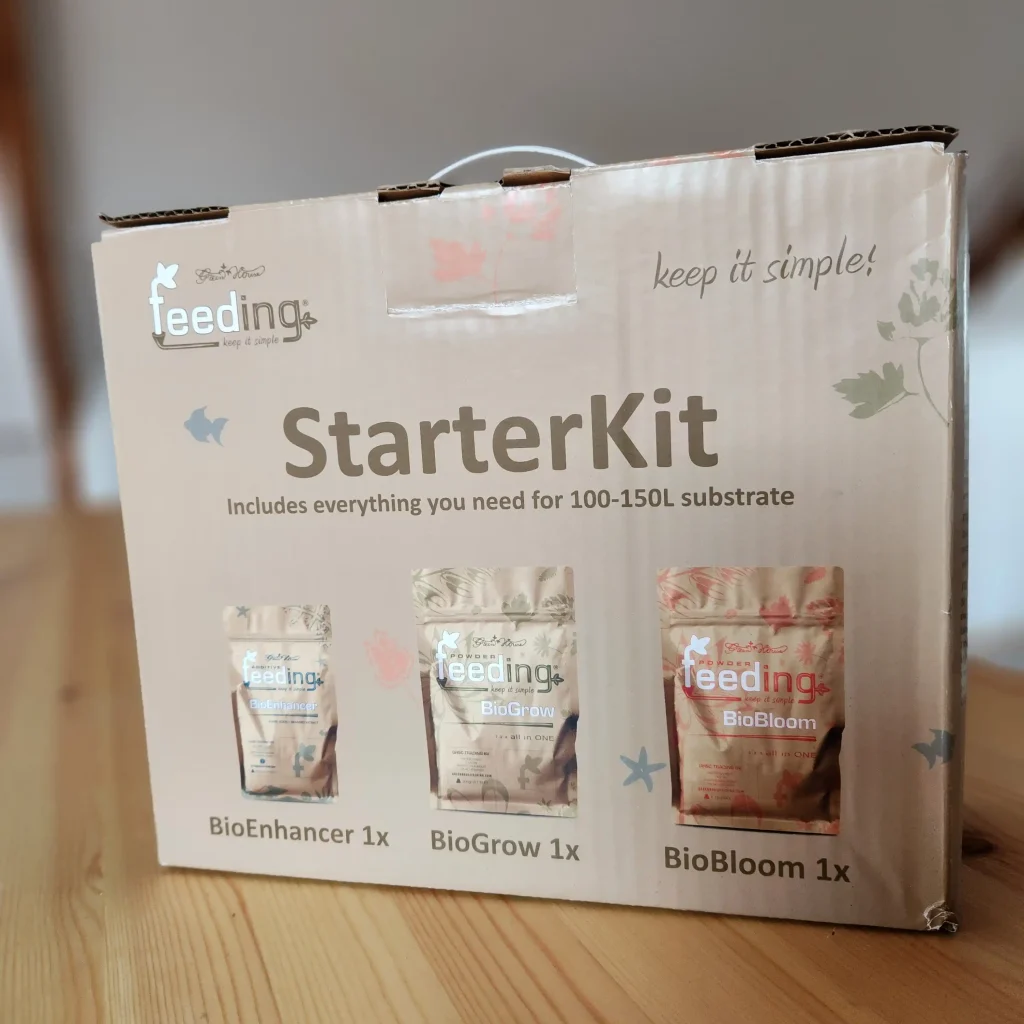
Mineral Line: All-in-One Nutrient Solutions
The Mineral Line by Green House Feeding provides complete, water-soluble nutrient formulas containing essential macro- and micro-elements, such as nitrogen (N), phosphorus (P), potassium (K), magnesium, calcium, and sulfur. These products are ideal for hydroponics, coco coir, and soil, delivering fast nutrient uptake. For optimal results, maintain a pH of 5.8–6.2 in hydroponic systems and monitor electrical conductivity (EC) to prevent nutrient buildup. Since these formulas lack calcium, growers using soft water (e.g., reverse osmosis or rainwater) should add a calcium supplement. Alternate with plain water to avoid salt accumulation.
Grow
Composition: NPK 24-6-12, high in nitrogen, with magnesium, sulfur, and micro-elements (e.g., iron, manganese).
Purpose: Designed for the vegetative stage, supporting leaf and stem growth, mother plants, and healthy cuttings. Suitable for all plant types, it promotes continuous growth and strong roots.
Application: Use 0.5 g/L for seedlings and 0.8–1 g/L for mature plants. In soil, apply 5–7 g per 10 liters; in hydroponics, combine with calcium (1.13 g/gallon for rockwool). Continue for 1–2 weeks into early flowering. For foliar spraying, dilute further.
Benefits: Encourages rapid green mass development and prevents nitrogen deficiency (yellowing leaves, stunted growth). Cost-effective, covering the entire vegetative phase with one product.
Considerations: Avoid overuse during flowering to prevent excessive stretching. Reduce dosage in hard water to prevent nutrient lockout.
Hybrid
Composition: NPK 15-7-22, balanced with reduced ammonium nitrogen and increased magnesium, plus sulfates for essential oils.
Purpose: Tailored for hybrid varieties (50/50 indica/sativa) with an 8–9-week flowering period, supporting both growth and bloom in hydroponics.
Application: Apply 0.7–1 g/L during flowering and 0.5 g/L for seedlings. Combine with Booster (0.56 g/gallon Hybrid + 0.28 g/gallon Booster) and increase dosage weekly.
Benefits: Enhances terpene, flavonoid, and essential oil production, improving flavor and aroma. Ideal for coco and rockwool, reducing magnesium deficiency risks.
Considerations: Not suitable for pure sativas due to their longer cycles. Monitor EC (1.5–2.0 mS/cm) to avoid overfeeding.
Short Flowering and Fast Flowering
Composition: NPK 12-14-24, rich in potassium with phosphorus and micro-elements for root development.
Purpose: Formulated for short-flowering hybrids (indica, autoflowers, <8 weeks), ensuring dense buds and uniform ripening.
Application: Use 0.5–0.7 g/L in vegetative stages and 0.7–1 g/L in flowering, adding Booster (0.2–0.5 g/L). For autoflowers, use throughout the cycle. In soil, apply 7–10 g per 10 liters.
Benefits: Boosts yield and prevents potassium deficiency (uneven ripening, weak stems). Simplifies feeding for autoflowers with a single product.
Considerations: Add calcium for soft water. Flush 1–2 weeks before harvest to remove excess salts.
Long Flowering
Composition: NPK 18-12-18, balanced with high phosphorus for roots and nitrogen for extended flowering.
Purpose: Suited for long-flowering sativas (>9–10 weeks), maintaining nitrogen levels and supporting robust root systems.
Application: Use 0.6–1 g/L, increasing to 1 g/L during flowering. In hydroponics, combine with Booster late in the cycle.
Benefits: Prevents weakening during late flowering and strengthens roots for larger plants.
Considerations: Avoid for short cycles due to excess nitrogen. Monitor pH in hydroponic setups.
Booster
Composition: NPK 0-30-27, a phosphorus-potassium (PK) booster with magnesium, no nitrogen.
Purpose: Enhances flowering by increasing yield, bud density, and resin production.
Application: Add 0.2–0.5 g/L mid-flowering (3–7 g per 10 liters with base nutrients). Avoid during vegetative growth.
Benefits: Boosts yield by 20–30% and accelerates flowering.
Considerations: Overuse can cause toxicity. Use only with base formulas like Hybrid or Short Flowering.
Calcium
Composition: NPK 6-0-0, chelated calcium.
Purpose: Prevents calcium deficiency (blossom-end rot, weak leaves) in soft water setups.
Application: Add 0.1–0.2 g/L with Mineral Line nutrients. In hydroponics, use 0.17 g/gallon.
Benefits: Stabilizes pH and strengthens cell walls for healthier plants.
Considerations: Avoid mixing with other CalMag products to prevent reactions. Use only with soft water.
Organic Line (Bio Feeding): Natural Nutrition for Soil
The Organic Line, or Bio Feeding, is 100% organic, designed for soil and coco coir. These fertilizers combine natural ingredients (bone meal, horn, seaweed) to stimulate soil microbiology, including beneficial fungi and bacteria. Nutrients release gradually over 8 weeks, enhancing flavor and aroma. Not suitable for hydroponics. Maintain soil pH between 6.0–7.0 for best results.
BioGrow
Composition: NPK 7-2-4, organic nitrogen from bone meal and horn, with micro-elements.
Purpose: Supports vegetative growth, promoting strong roots, leaves, and soil microbiota for rapid development.
Application: Mix 2–3 g/L of substrate at planting. For mother plants, apply as top-dressing every 2 months. Use half the dose for seedlings.
Benefits: Builds healthy roots, increases disease resistance, and delivers organic flavor.
Considerations: Reduce dosage in pre-fertilized substrates. Nutrient release takes 8 weeks.
BioBloom
Composition: NPK 4-9-9, organic phosphorus and potassium from bone meal and winery pomace, with 18% organic carbon, 8% CaO, and 4% MgO.
Purpose: Enhances flowering, boosting yield, flavor, and aroma while supporting soil microbiology.
Application: Mix 2–3 g/L of substrate before flowering, with top-dressing mid-cycle. Ideal for 8-week flowering periods.
Benefits: Provides natural phosphorus and potassium release, forms humus, and increases resin and terpene production.
Considerations: Effectiveness depends on soil microbes, requiring proper temperature and moisture. Certified for organic cultivation.
BioEnhancer
Composition: Blend of humic acids, seaweed extracts, Trichoderma harzianum, and Bacillus subtilis.
Purpose: Improves nutrient uptake, protects roots, and boosts growth throughout the plant cycle.
Application: Use 0.5–1 g/L of water every 2 weeks for root or foliar feeding. For cuttings/seeds, apply 1 g/L. Use within 24 hours of mixing.
Benefits: Enhances microbiota, increases pathogen resistance, and improves yield. Versatile for roots, leaves, and soil.
Considerations: Do not store mixed solutions, as bacteria lose activity. Pairs well with BioGrow and BioBloom.
Starter Kits and Supplements
Bio Starter Kit: Includes BioEnhancer (125 g), BioGrow (500 g), and BioBloom (500 g), sufficient for 100–150 liters of substrate across multiple cycles. Ideal for beginners, mix with soil for a complete organic cycle. Includes a catalog and bottle. Offers cost savings, simplicity, and organic certification.
BioRoot Protector: A microbial supplement (Trichoderma, Bacillus) for protection against root pathogens like fungi and bacteria. Apply during early stages via irrigation or substrate for root rot prevention. Strengthens plant immunity and complements the Bio Line.
Why Choose Green House Feeding?
Green House Feeding fertilizers are globally trusted, available in growshops and through online retailers with fast worldwide shipping. Popular among growers, they earn 4–5 star ratings on platforms like GrowDiaries and THCFarmer for ease of use and reliable results. Suitable for cannabis and other crops, these products emphasize eco-friendliness (Organic Line) and simplicity («Keep it Simple!»). The brand offers a nutrient calculator on its website for tailored feeding schedules. Beginners should start with half doses to avoid overfeeding, and growers using hard water must monitor EC to prevent nutrient lockout.
For hydroponic setups, choose the Mineral Line for fast nutrient delivery. For organic soil growing, opt for the Bio Feeding Line to enhance flavor and sustainability. Always test on a small scale before full application to ensure compatibility with your setup.
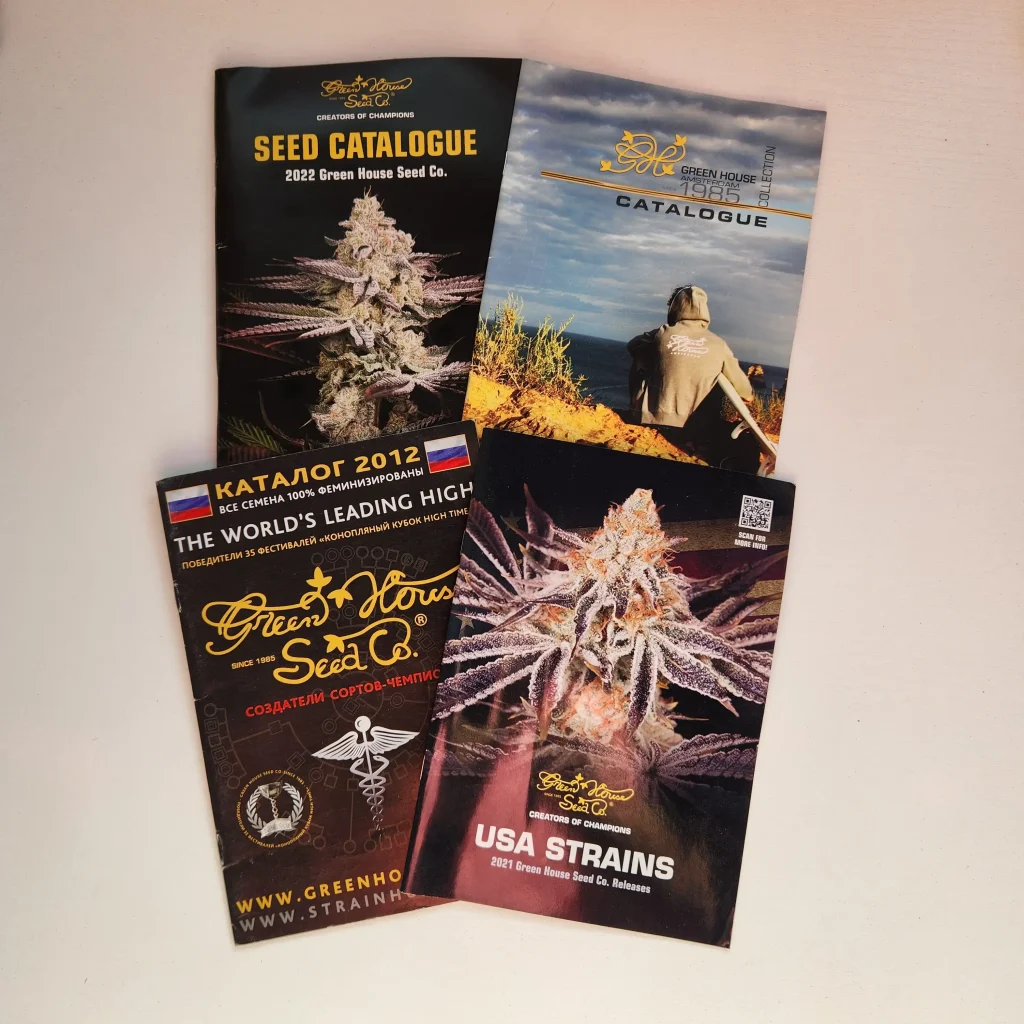
Over the course of its existence, Green House Seeds has printed literally several trainloads of catalogs of all sizes and formats in at least a dozen languages. Green House Seed Co. catalogs represent a whole layer of cannabis culture. They showcase thoughtful design, high-quality materials, and professional presentation. Even in the office, we’ve probably lost count of the number of copies printed, so we’ll simply provide photos of just a few.

Catalog Design.
The covers feature bright, eye-catching close-up images of plants, making them easy to read even after consuming Green House Seeds products. A contrasting color palette is used: a dark background with gold and white accents for logos and text («Green House Seed Co.», «Creators of Champions»), creating a premium look.
Branding elements, such as logos and catchy slogans like «World’s Leading Cannabis Seed Company,» are featured throughout the brochure, ensuring recognition. The presence of QR codes adds a modern, interactive element and facilitates navigation to the website.
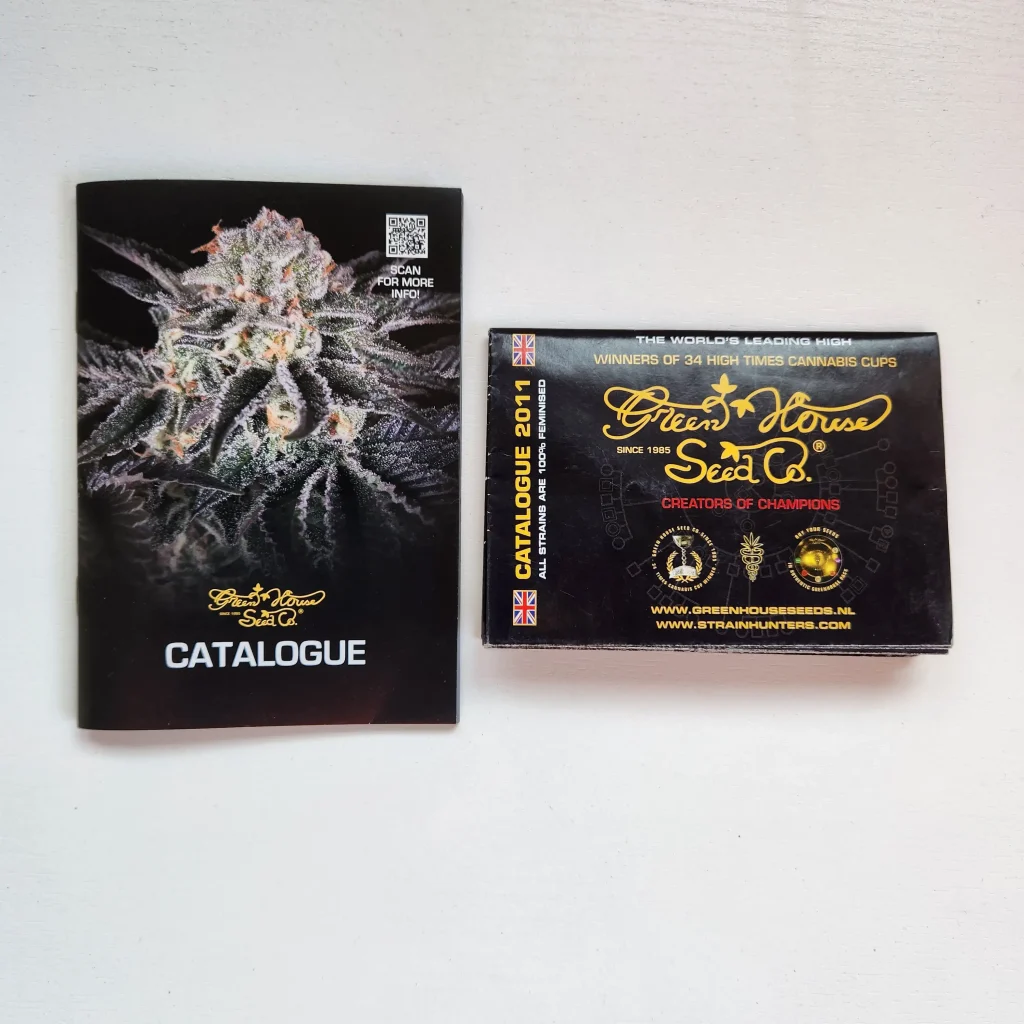
Paper and Format.
All catalogs, with rare exceptions, use expensive, high-quality glossy paper, which protects against wear and enhances the vibrancy of the images. The texture and sheen of the photos suggest a thicker material, typical of premium catalogs. The A5 format is very compact and convenient for storing and reading; everything has been thoughtfully designed!
The catalogs are neatly designed, with clear typography and text alignment, indicating a highly professional layout and printing. The multilingual approach indicates a focus on an international audience. Importantly, the year of publication and special editions, such as «USA Strains Releases,» create a sense of collectible value and relevance.
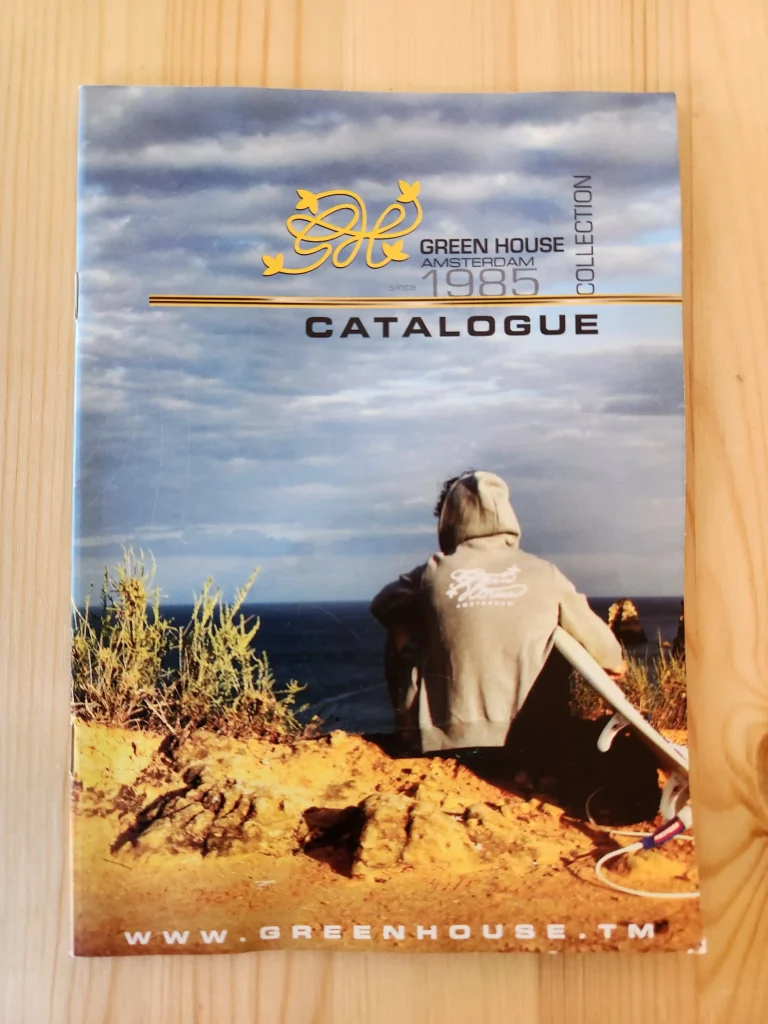
Merchandising Catalog.
In 2019, a separate catalog exclusively devoted to merchandising was printed, an absolute novelty for the cannabis business at that time. Collected here are caps, T-shirts, hoodies, rolling papers, grinders, and all the other trinkets that delight fans and are the pride of collectors. A closer look reveals that Green House Seeds produces so much branded clothing that you could dress yourself from head to toe. The catalog is 16 pages densely packed with product photos.
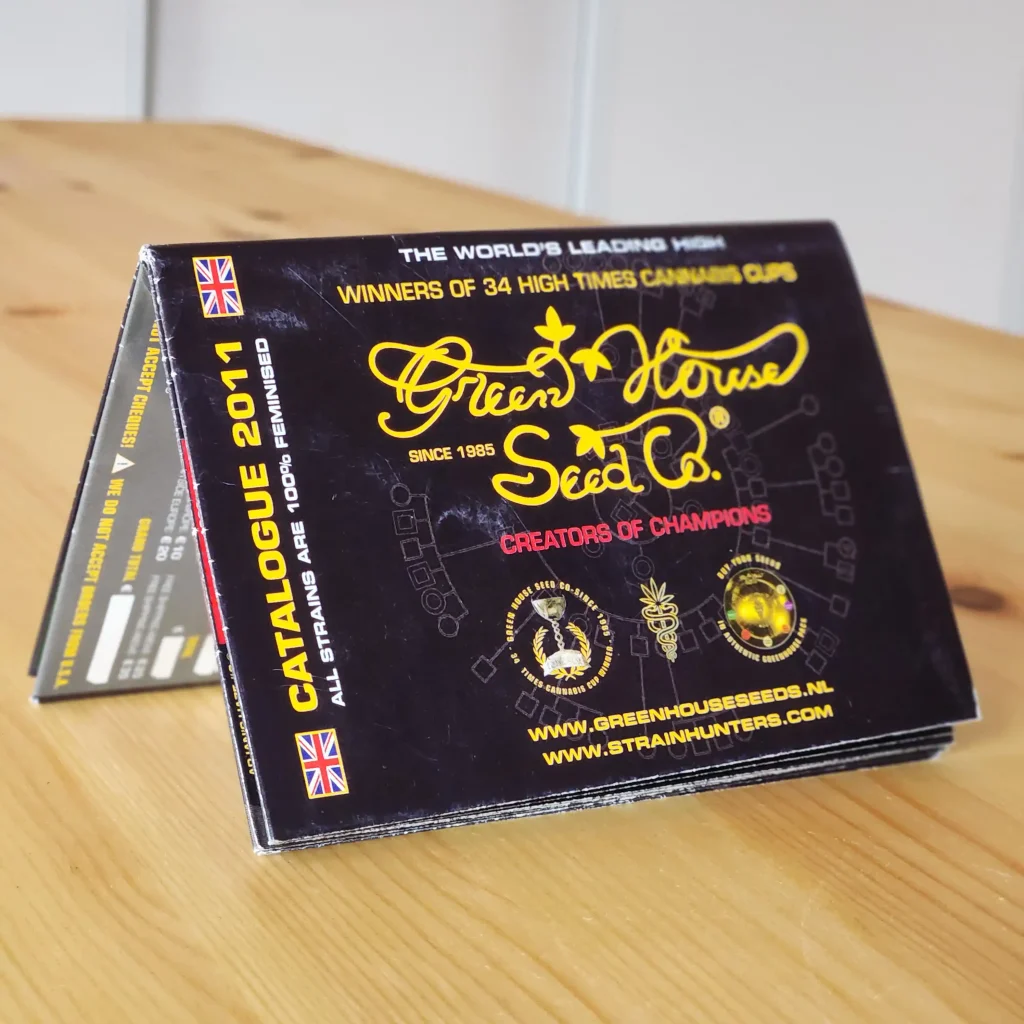
Fold-out catalog
In 2014, a pocket-sized, folding catalog was printed. Despite its size when folded, it can cover a medium-sized table when unfolded. It was timed to coincide with the launch of a marijuana growing website featuring HD videos, a completely new feature at the time. The catalog itself not only listed all the seed varieties available for purchase but also included a «flavor wheel,» a signature Green House Seeds feature that helps navigate the diverse selection.
Overall, the abundance, style, and design of the catalogs underscores the company’s status as a leader in its niche, combining aesthetics and functionality.
The history of Green House Seeds coffeeshops began in 1992, when Arjan Roskam, known as the «Cannabis King,» opened the first coffeeshop, The Green House, at Tolstraat 91 in Amsterdam-South. This was shortly after Roskam began experimenting with exotic cannabis strains from trips to Thailand, Nepal, and other countries and earned his first income.
The coffeeshop quickly became popular thanks to its high-quality product and unique atmosphere—it even served alcohol, a rarity for such establishments.
The success of the first coffeeshop was reinforced by victories at the prestigious High Times Cannabis Cup: in 1993, Green House won the overall category, and in 1994, it won in almost every category. This attracted international press attention, including High Times, which featured Arjan on its cover in 1995, and celebrity attention, which contributed to the chain’s expansion.
Today, Green House has four coffeeshops and two clubs in Amsterdam, including its flagship on the Tolstraat, as well as other locations such as Green House on the canal near the Red Quarter and Greenhouse United.
The coffeeshops and Green House itself were originally founded by Roskam in partnership with other prominent figures in the cannabis industry, including Nevil Schoenmakers, an Australian breeder and founder of the first cannabis seed bank, The Seed Bank. Schoenmakers co-founded and helped manage the coffeeshops, contributing to the development of strains such as Super Silver Haze, which won Cannabis Cup victories.
In 1998, Shanti-Baba (Scott Blakey), another co-founder of the company, sold his stake to Roskam, allowing him to become the sole owner of Green House Seed Company. Similarly, around 1999–2000, Schoenmakers sold his stake in one of the coffee shops to Roskam. According to industry insiders, serious disagreements arose between Schoenmakers and Roskam, including conflicts over management and genetics. These conflicts escalated into a desire to split the business.
The split took about two years, and after Schoenmakers’ departure, the quality of Green House products, according to some critics, declined—the company was even disqualified from the Cannabis Cup for attempting to bribe the jury.
Currently, Roskam remains the chain’s majority owner, but he has partners such as Joachim «Joa» Helms, co-owner of the legendary Green House coffee shop and a cannabis activist.
In 2016–2017, Green House Seed Company entered into partnerships with American brands (such as O.penVAPE and Canopy Growth), but these were for products, not coffee shops.
The Green House chain remains one of the most influential in Amsterdam, despite tightened regulations for coffee shops.